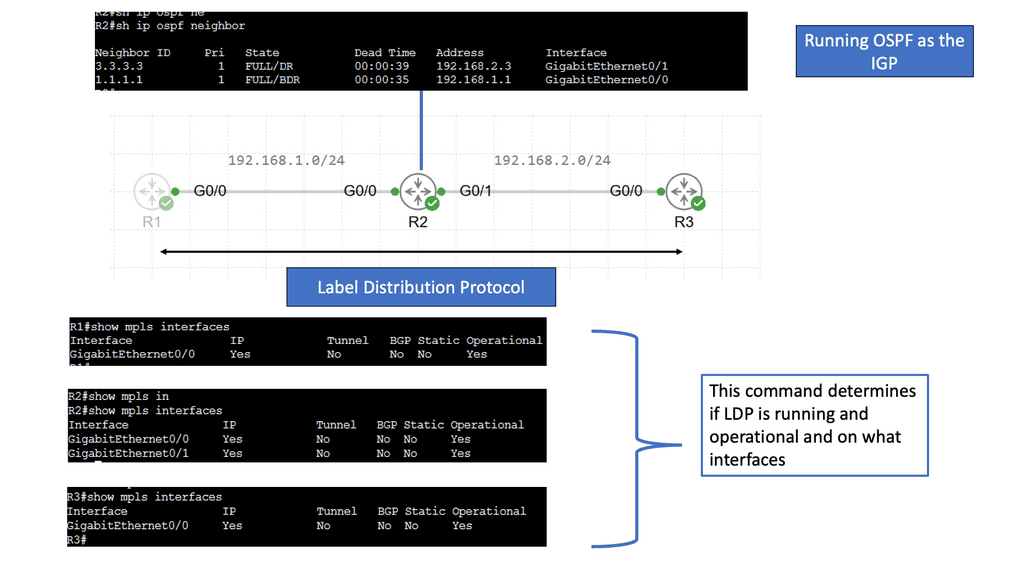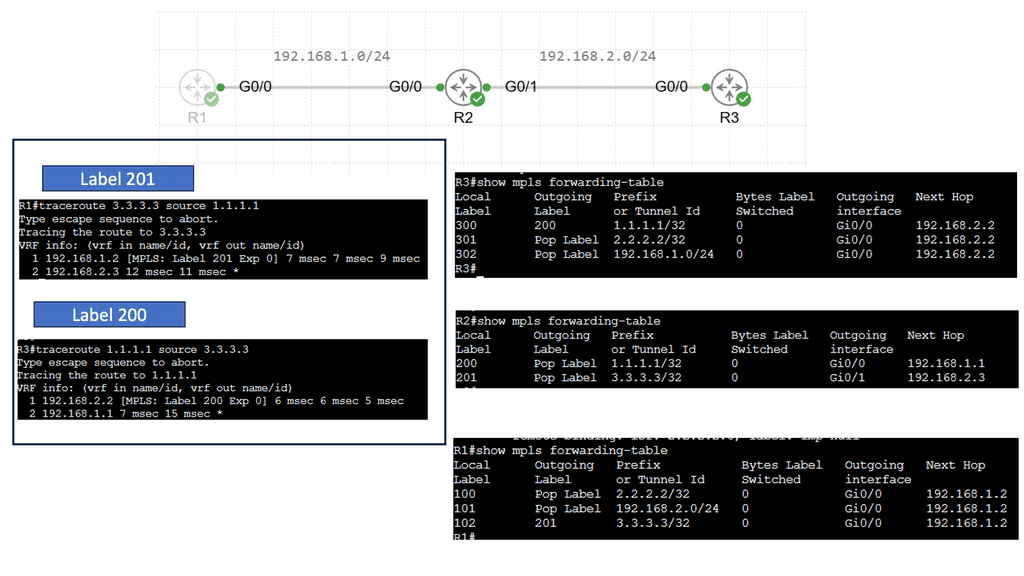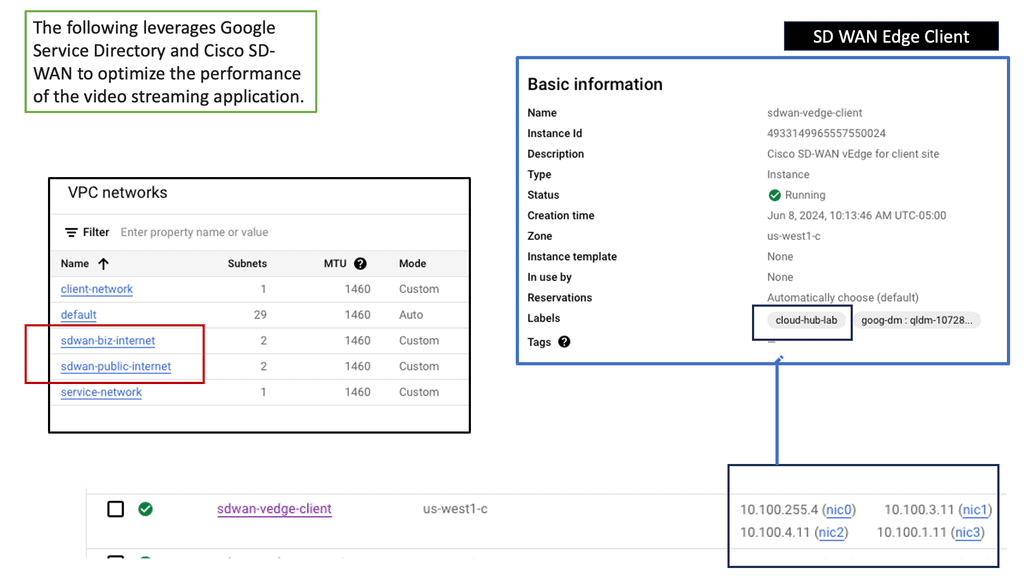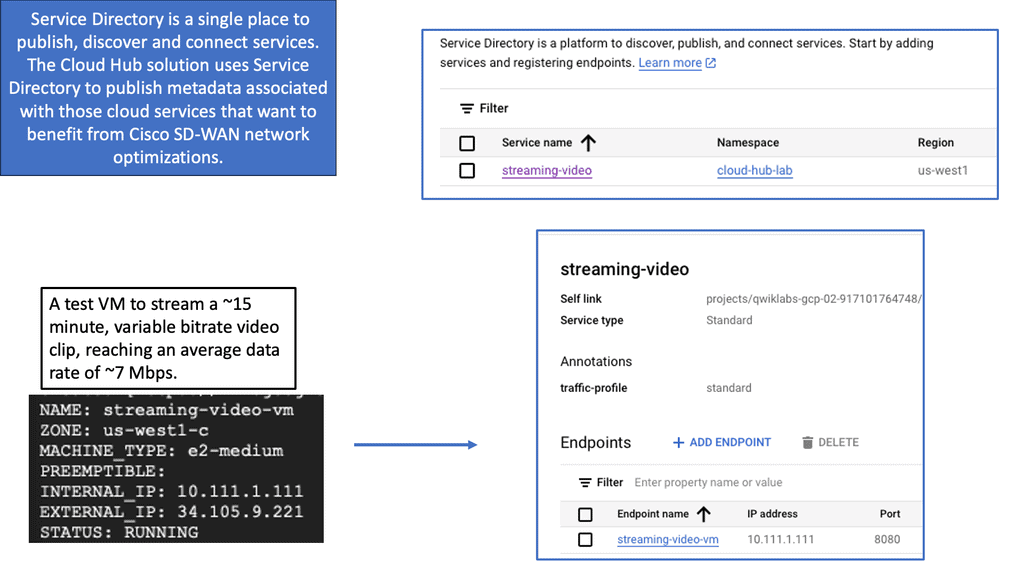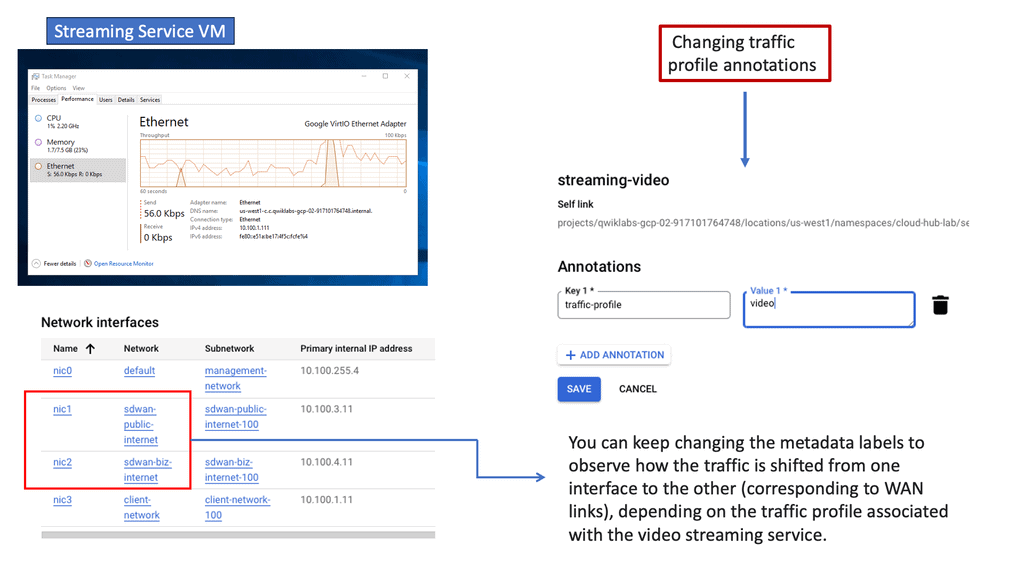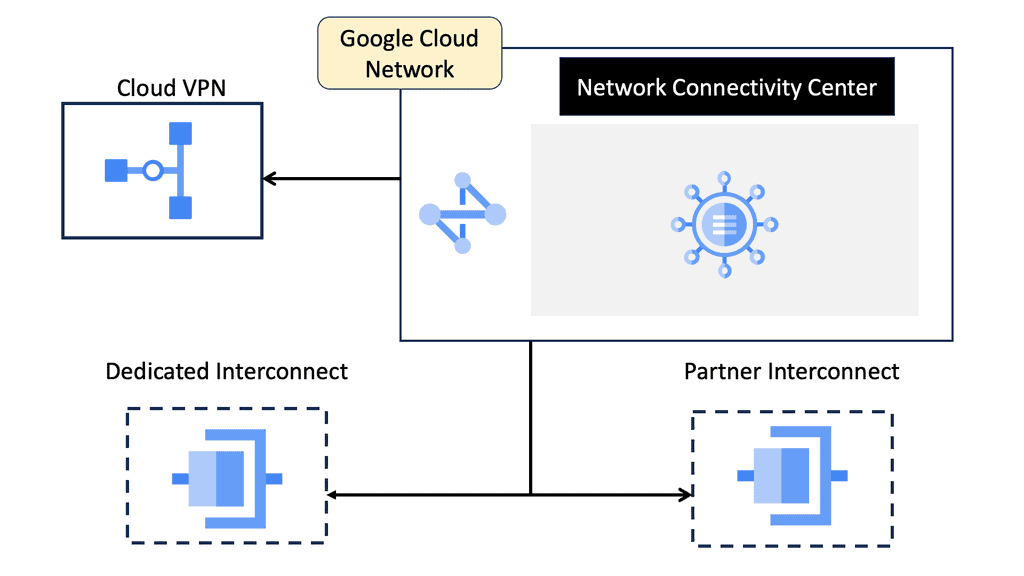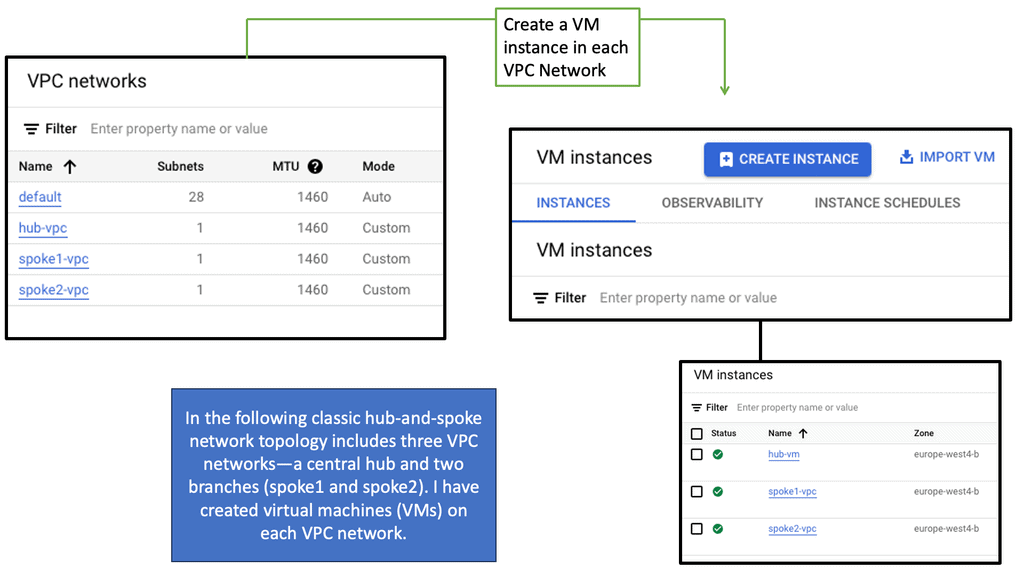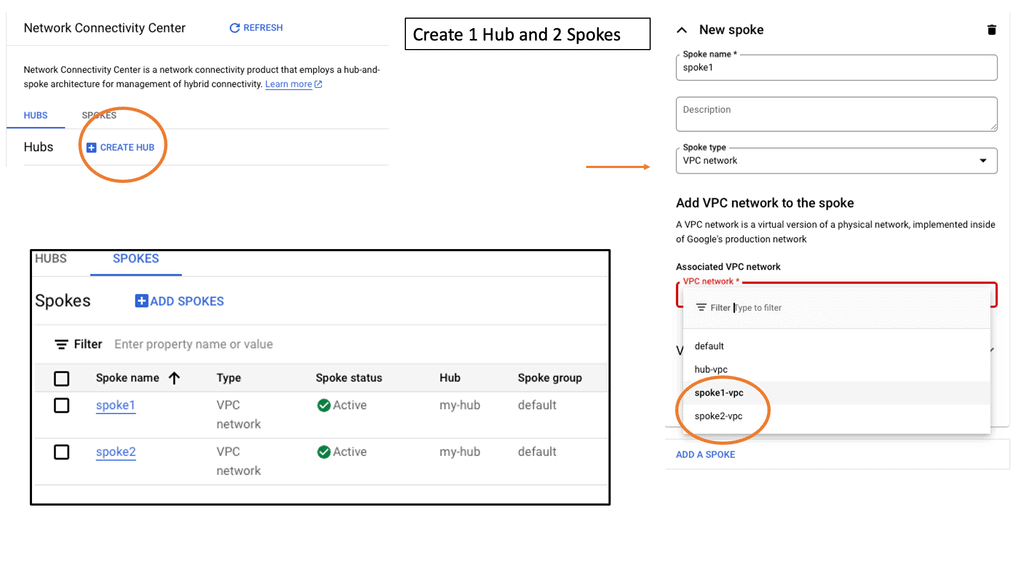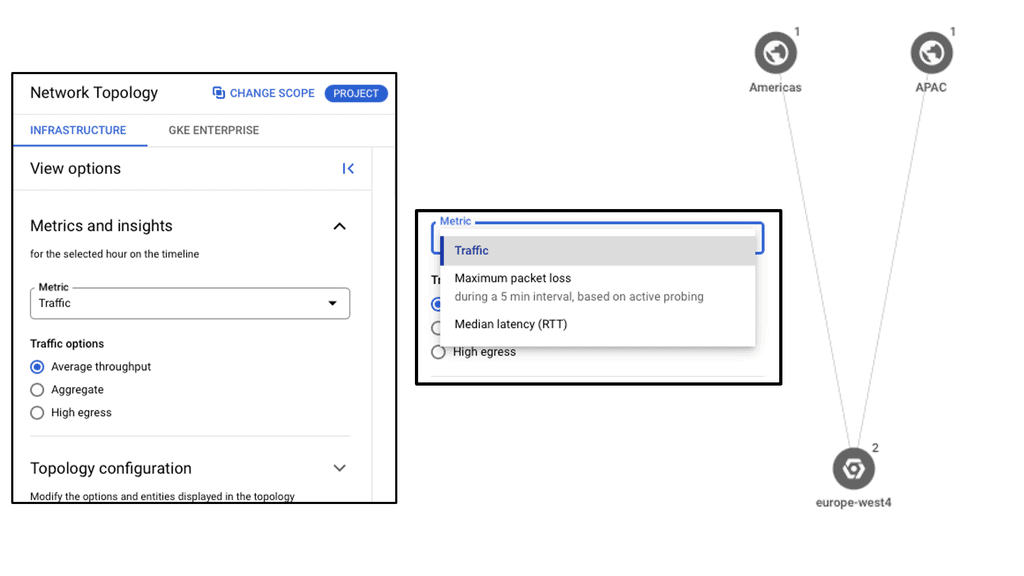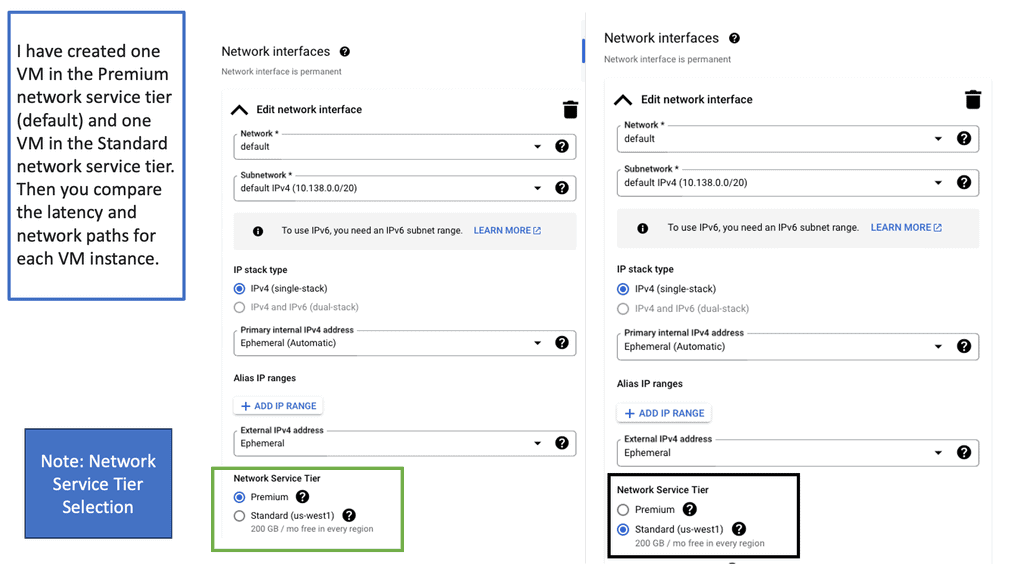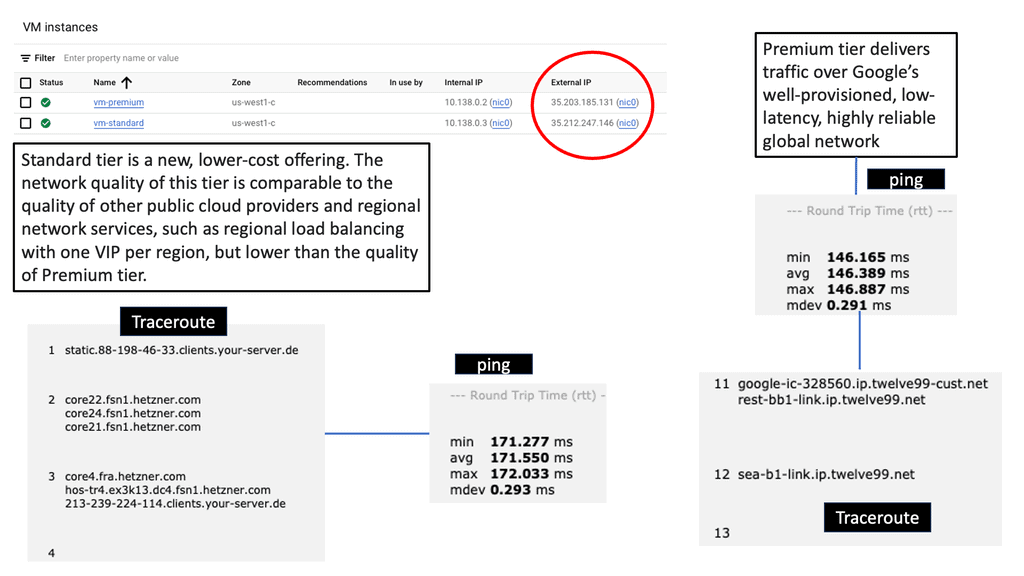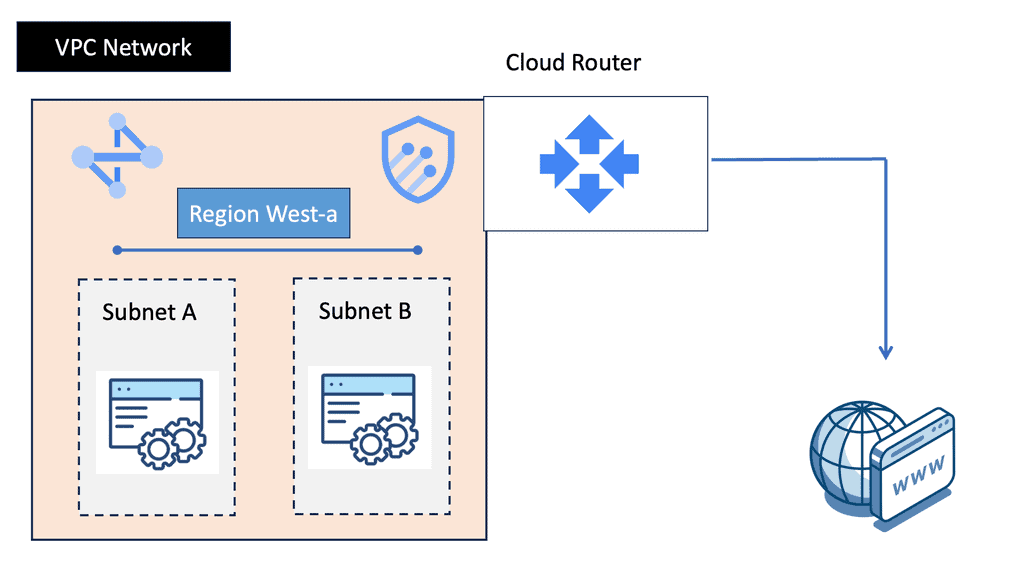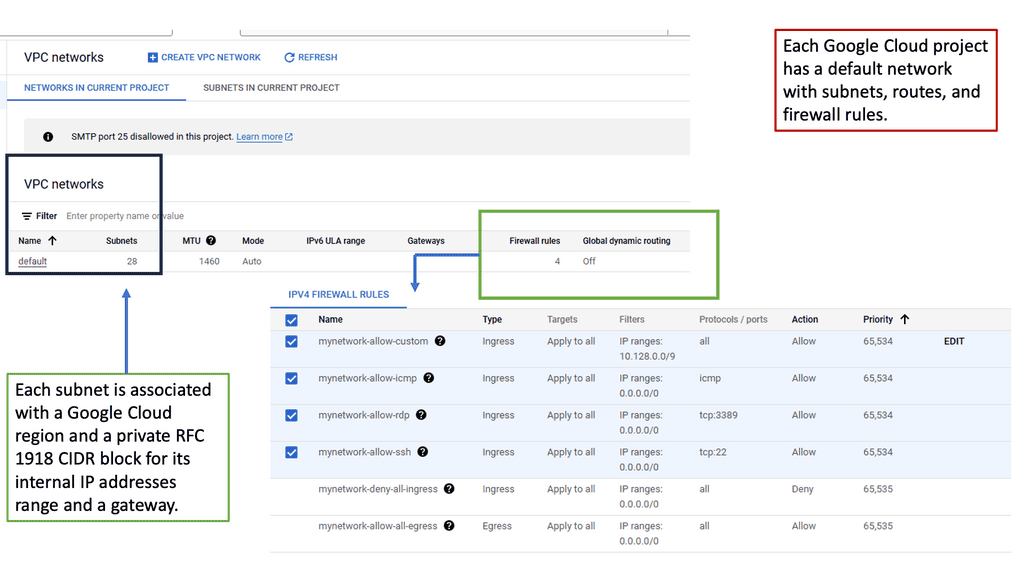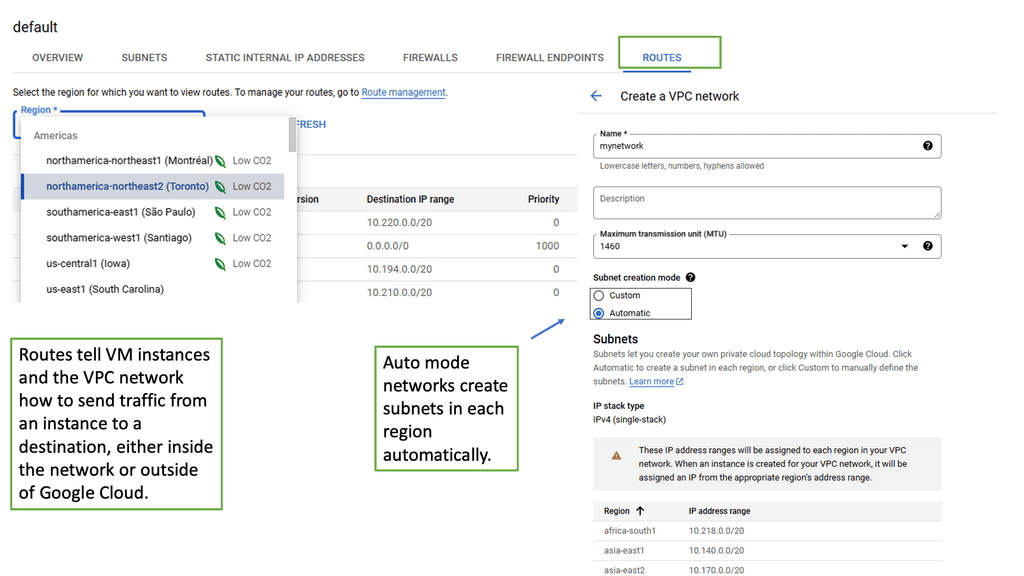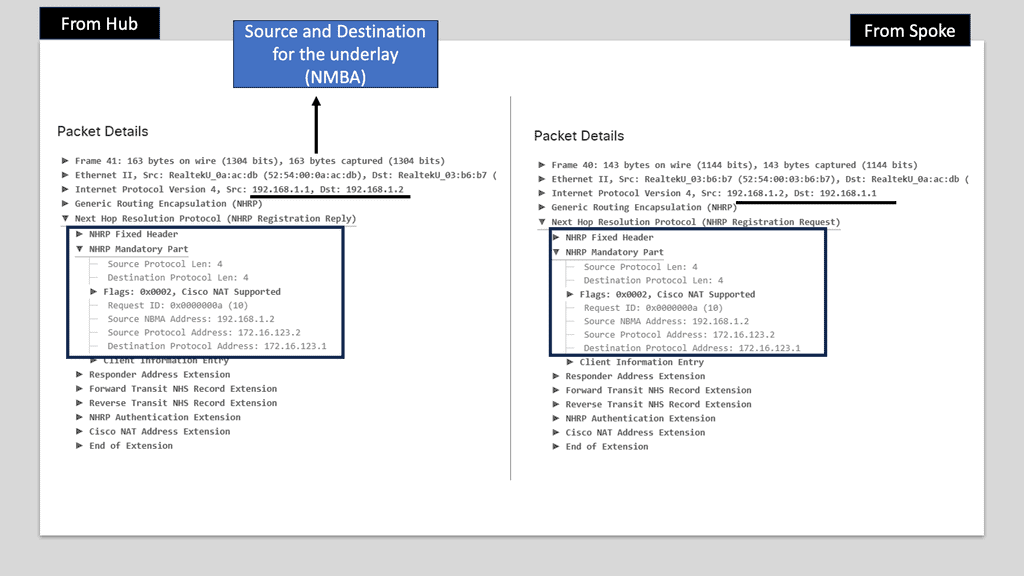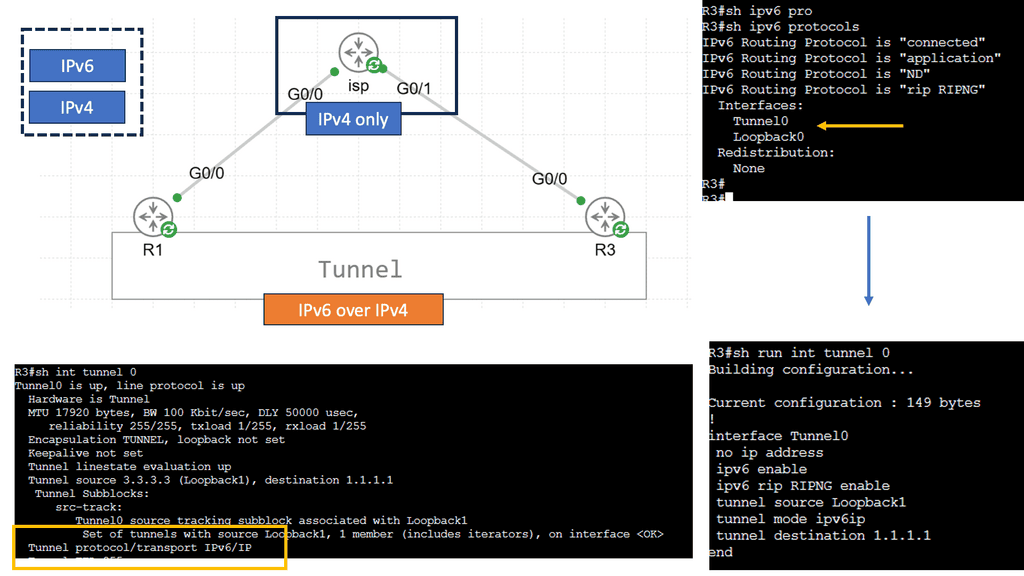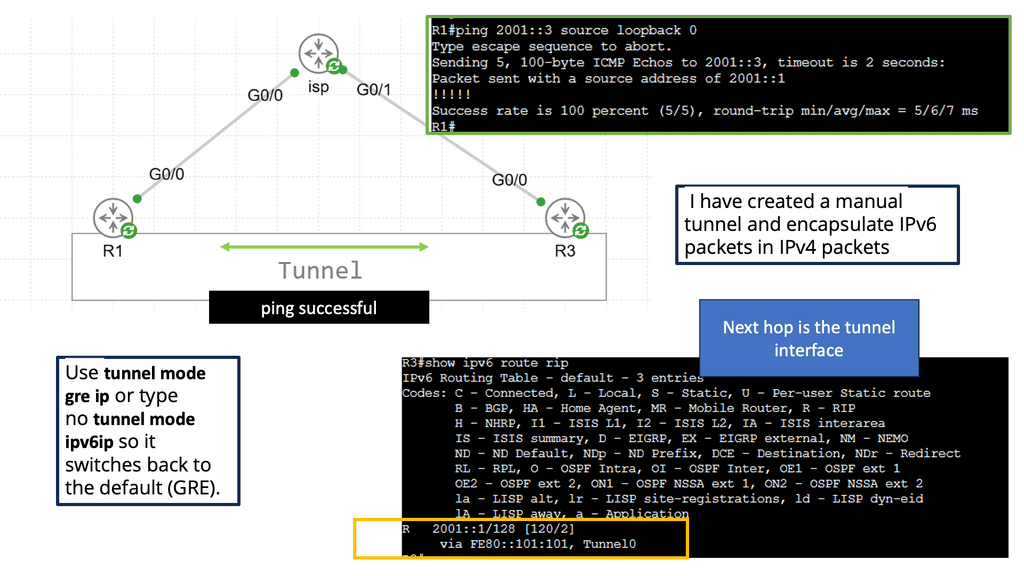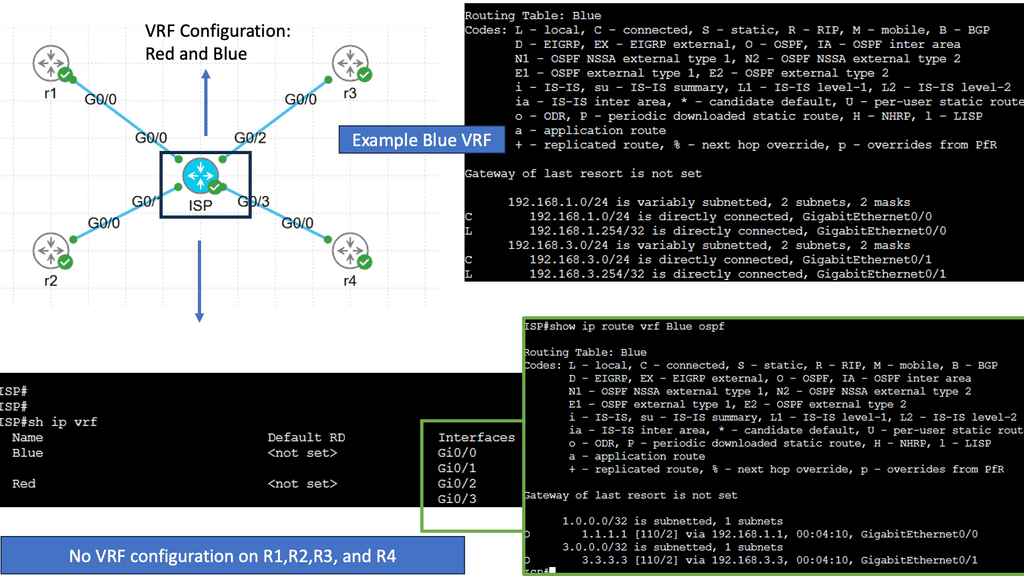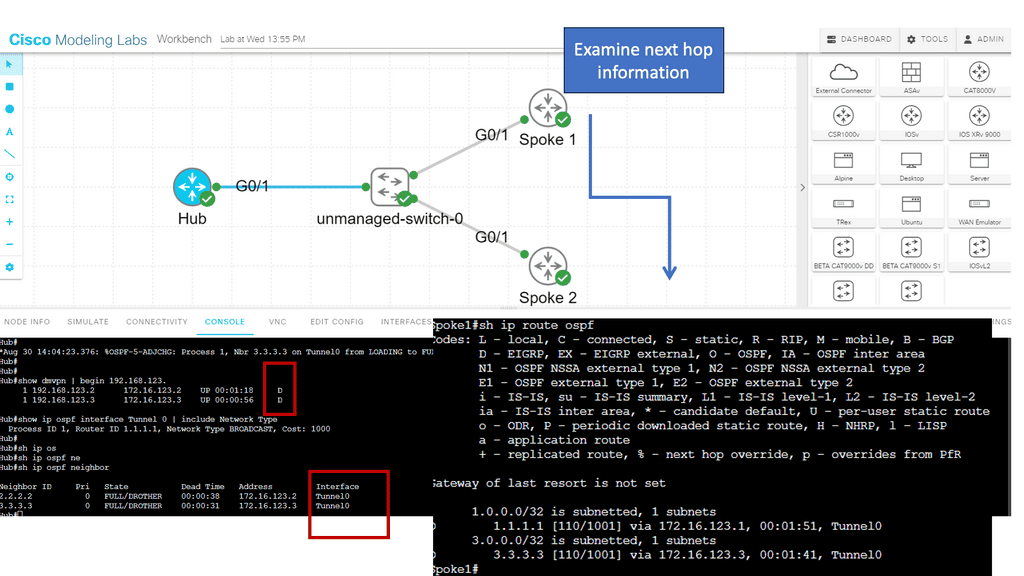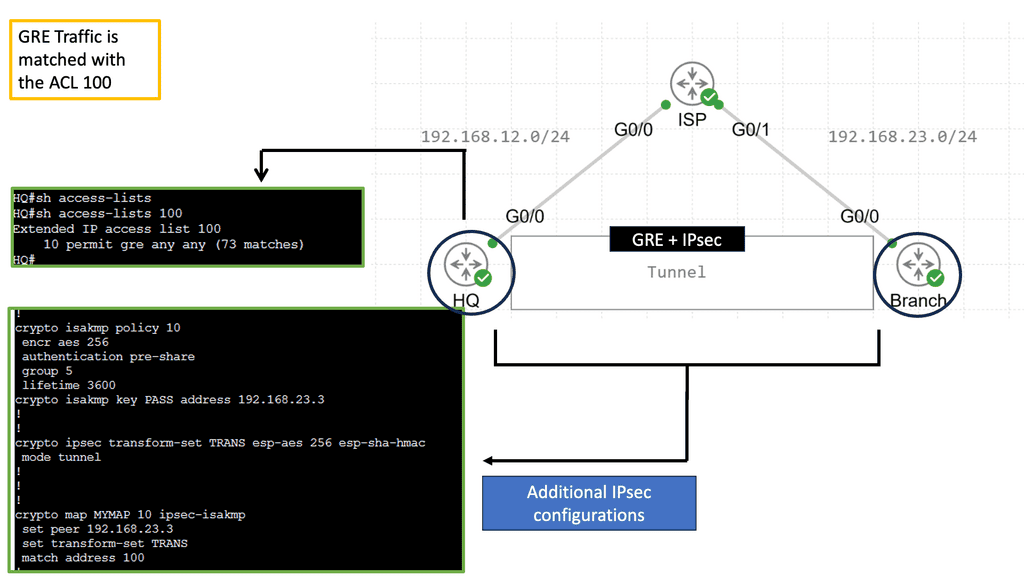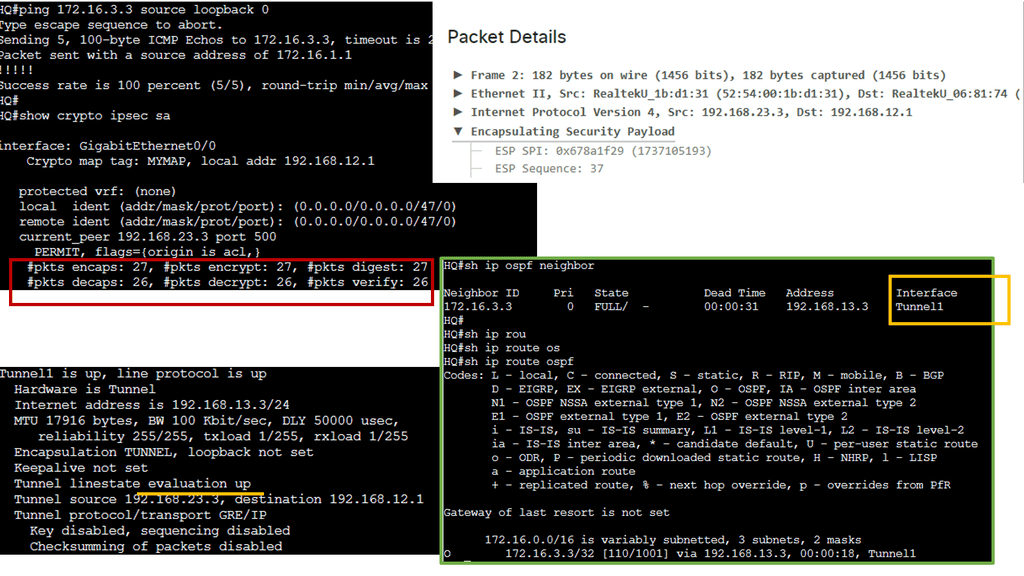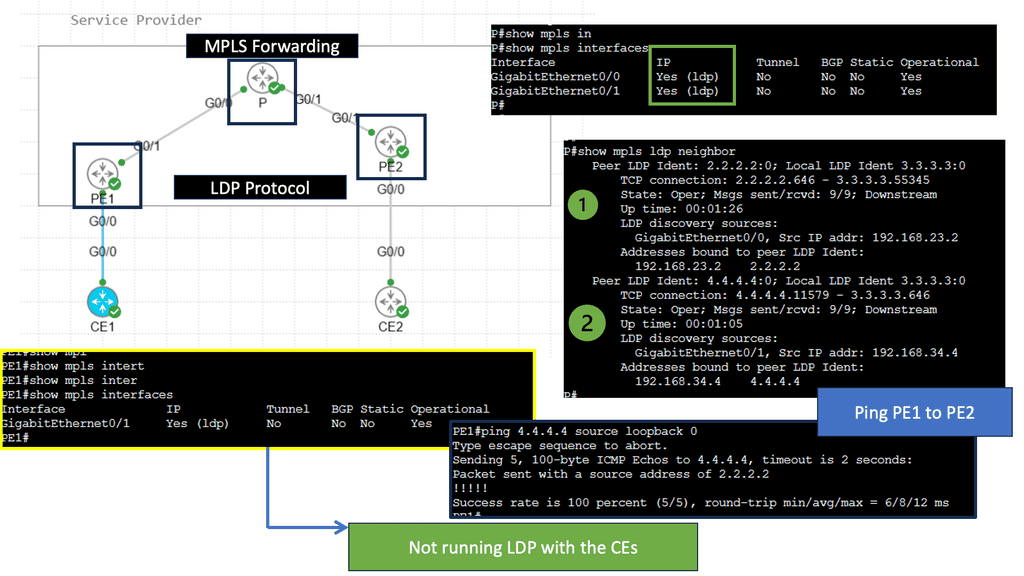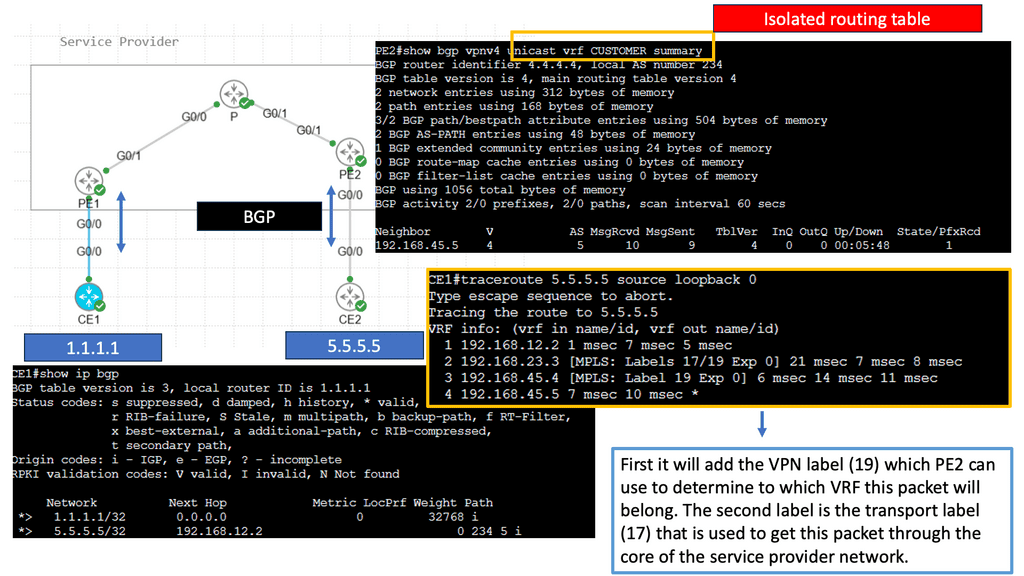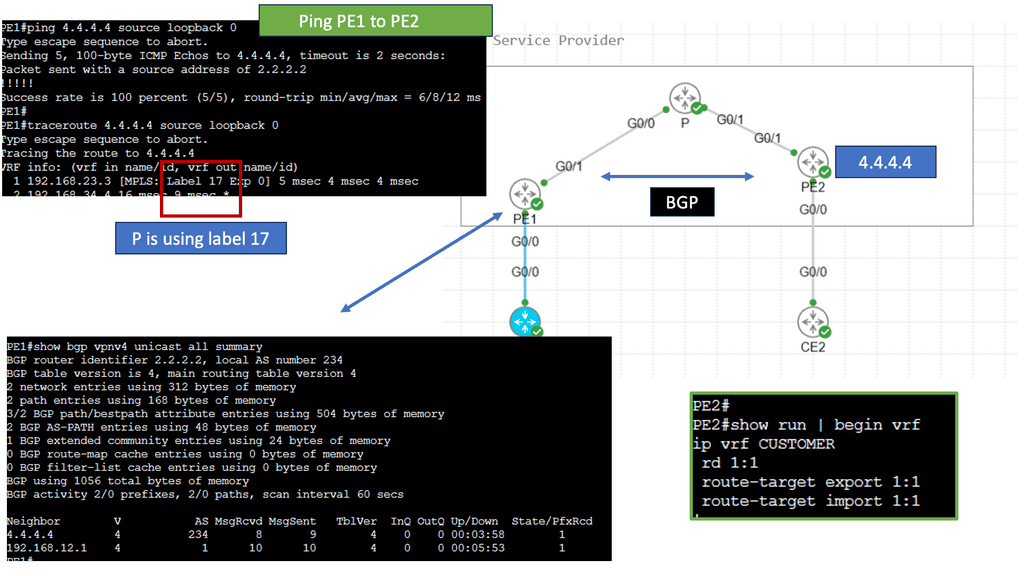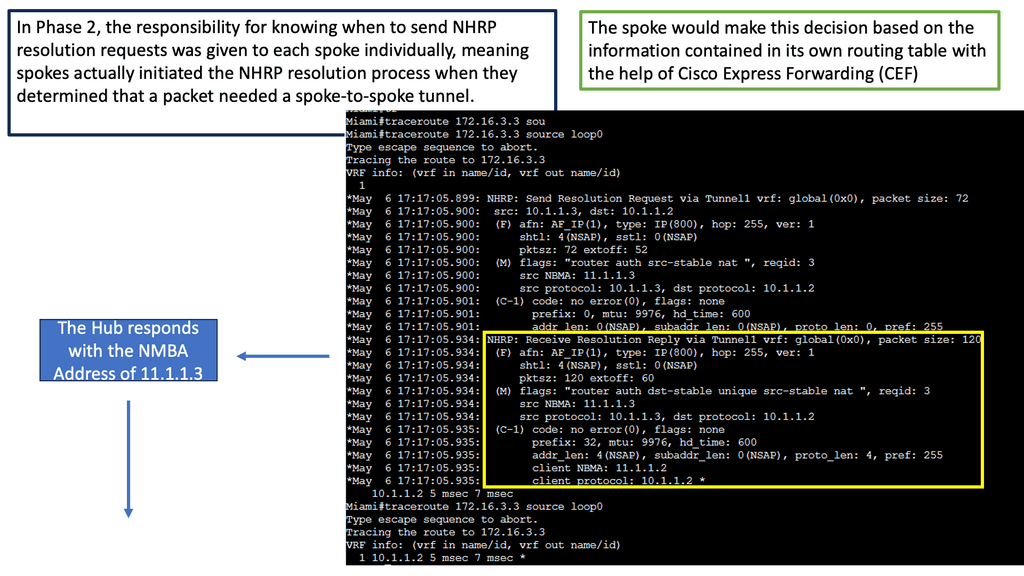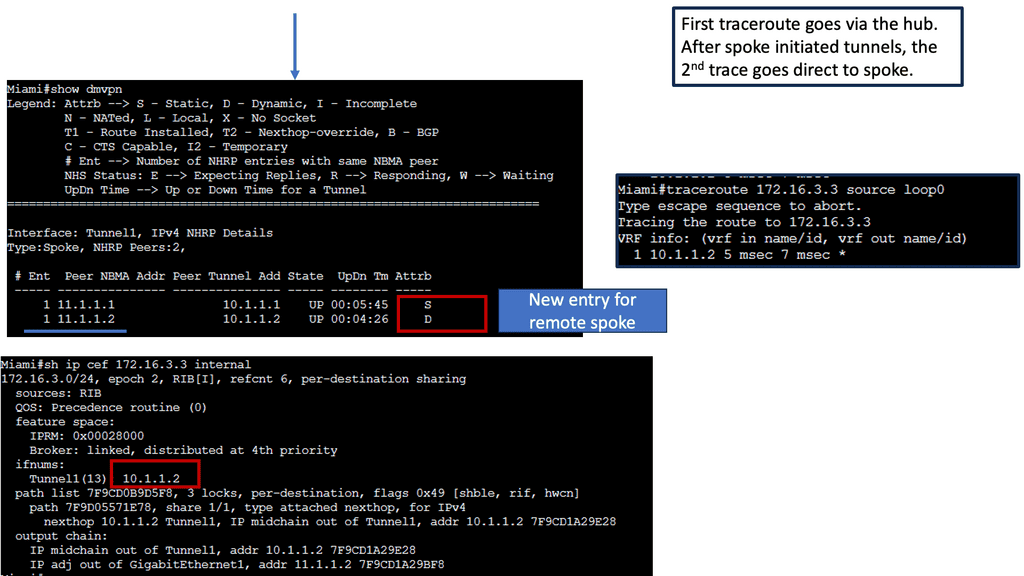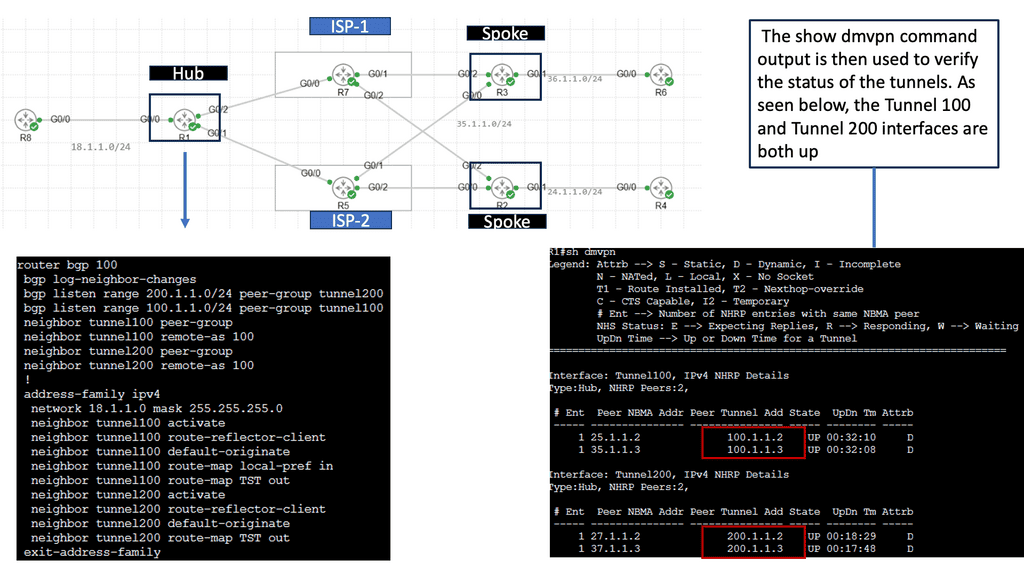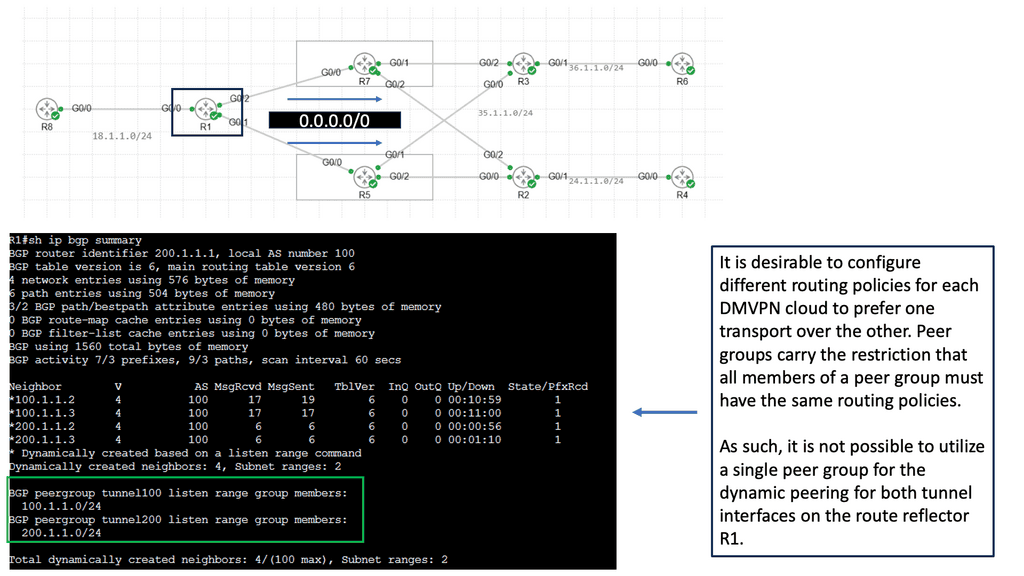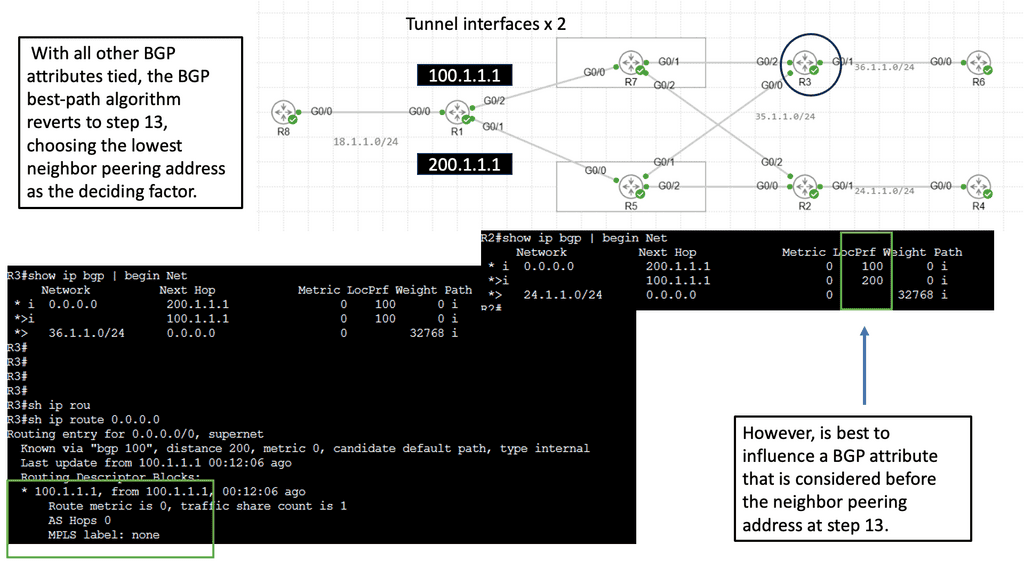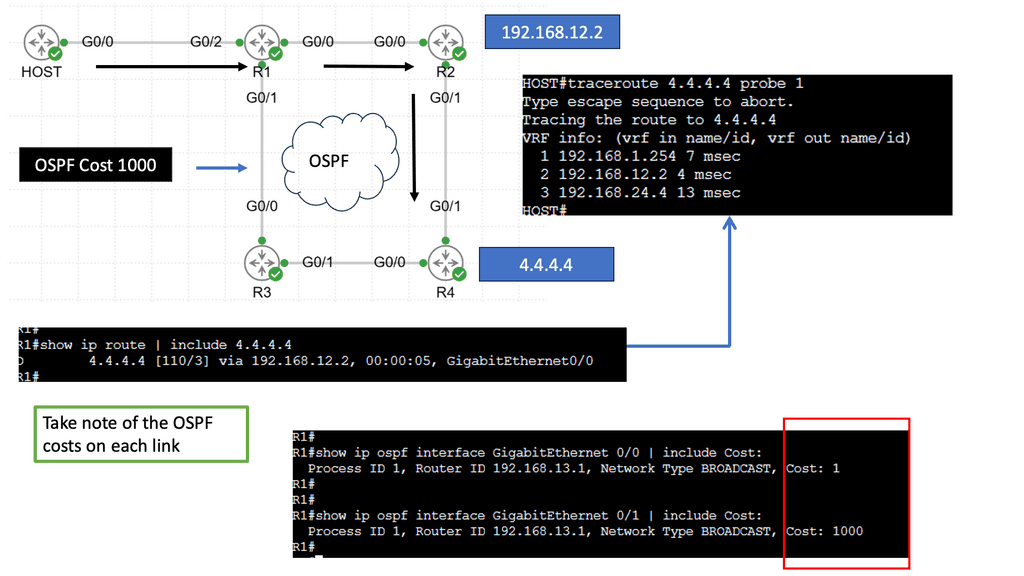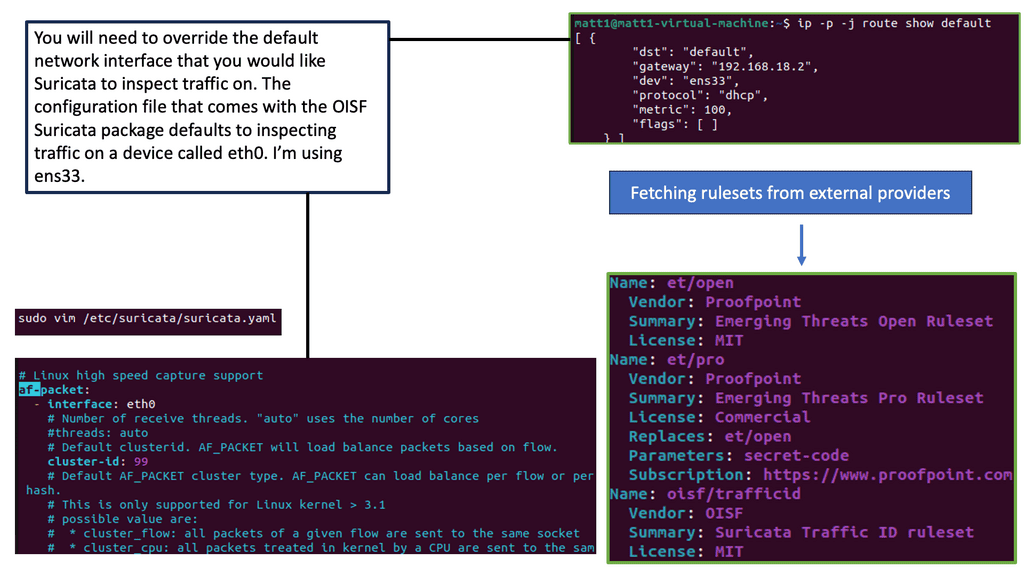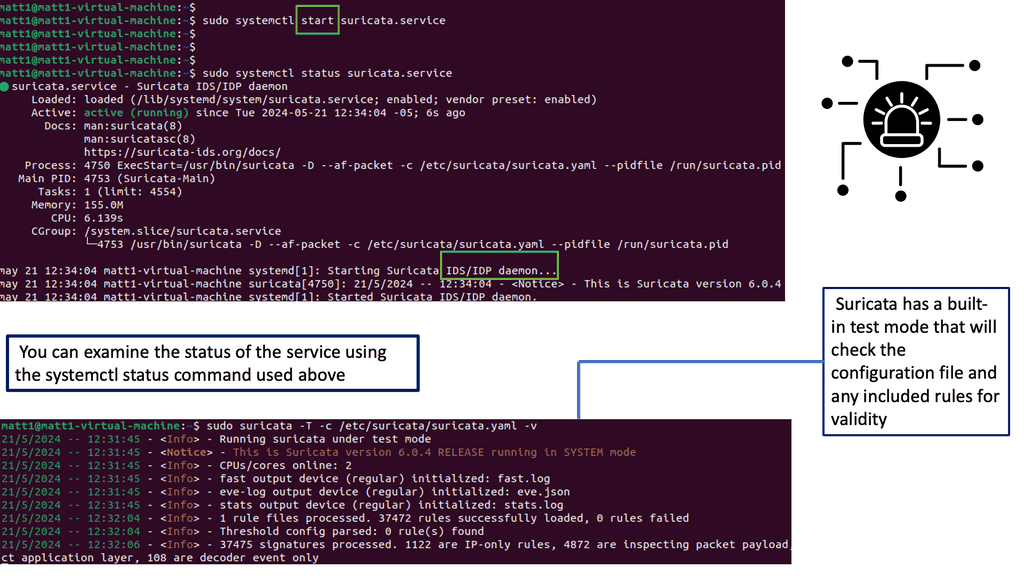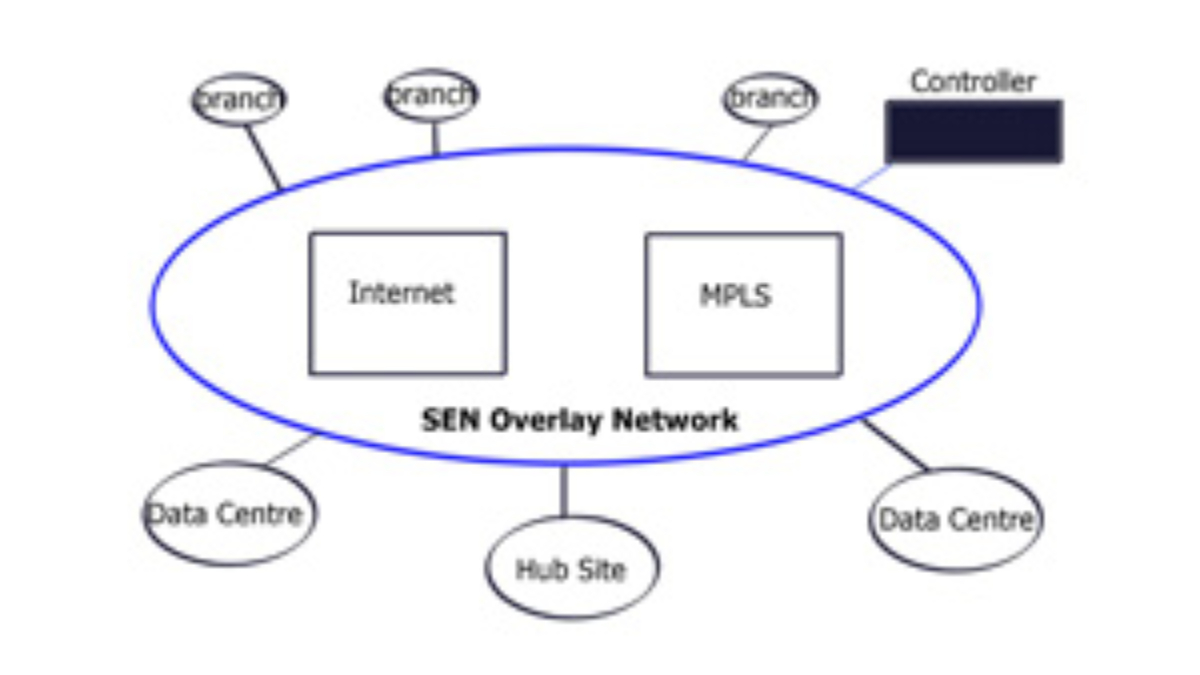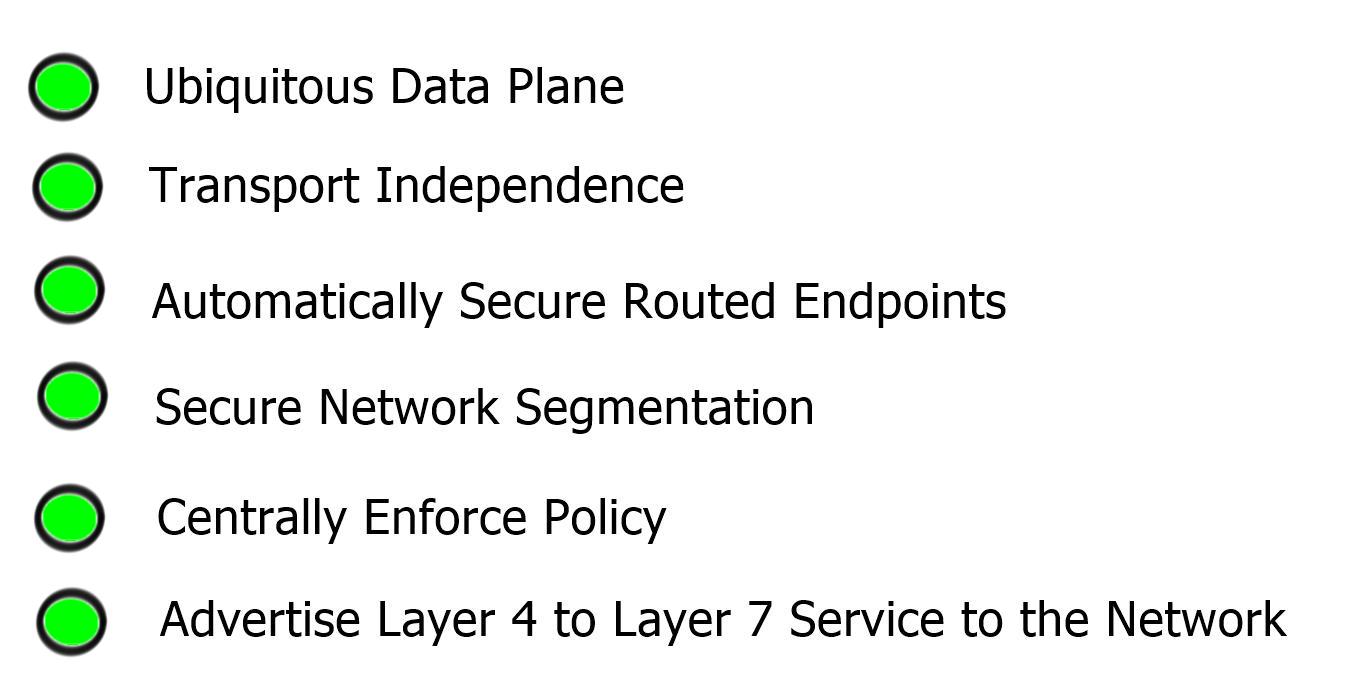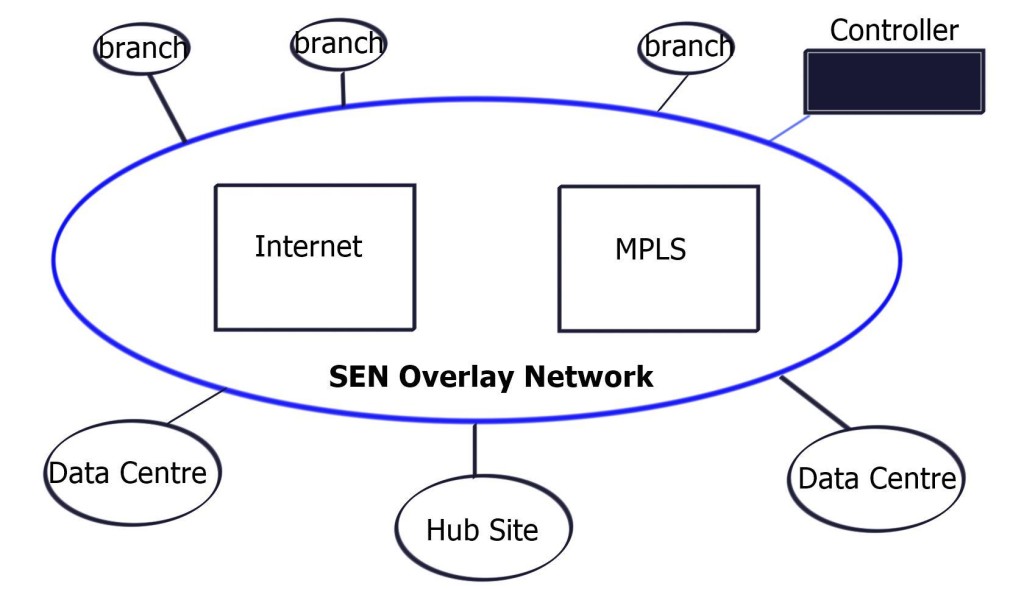WAN Virtualization
In today's fast-paced digital world, seamless connectivity is the key to success for businesses of all sizes. WAN (Wide Area Network) virtualization has emerged as a game-changing technology, revolutionizing the way organizations connect their geographically dispersed branches and remote employees. In this blog post, we will explore the concept of WAN virtualization, its benefits, implementation considerations, and its potential impact on businesses.
WAN virtualization is a technology that abstracts the physical network infrastructure, allowing multiple logical networks to operate independently over a shared physical infrastructure. It enables organizations to combine various types of connectivity, such as MPLS, broadband, and cellular, into a single virtual network. By doing so, WAN virtualization enhances network performance, scalability, and flexibility.
Increased Flexibility and Scalability: WAN virtualization allows businesses to scale their network resources on-demand, facilitating seamless expansion or contraction based on their requirements. It provides flexibility to dynamically allocate bandwidth, prioritize critical applications, and adapt to changing network conditions.
Improved Performance and Reliability: By leveraging intelligent traffic management techniques and load balancing algorithms, WAN virtualization optimizes network performance. It intelligently routes traffic across multiple network paths, avoiding congestion and reducing latency. Additionally, it enables automatic failover and redundancy, ensuring high network availability.
Simplified Network Management: Traditional WAN architectures often involve complex configurations and manual provisioning. WAN virtualization simplifies network management by centralizing control and automating tasks. Administrators can easily set policies, monitor network performance, and make changes from a single management interface, saving time and reducing human errors.
Multi-Site Connectivity: For organizations with multiple remote sites, WAN virtualization offers a cost-effective solution. It enables seamless connectivity between sites, allowing efficient data transfer, collaboration, and resource sharing. With centralized management, network administrators can ensure consistent policies and security across all sites. Cloud Connectivity:
As more businesses adopt cloud-based applications and services, WAN virtualization becomes an essential component. It provides reliable and secure connectivity between on-premises infrastructure and public or private cloud environments. By prioritizing critical cloud traffic and optimizing routing, WAN virtualization ensures optimal performance for cloud-based applications.Matt Conran
Highlights: WAN Virtualization
### The Basics of WAN
A WAN is a telecommunications network that extends over a large geographical area. It is designed to connect devices and networks across long distances, using various communication links such as leased lines, satellite links, or the internet. The primary purpose of a WAN is to facilitate the sharing of resources and information across locations, making it a vital component of modern business infrastructure. WANs can be either private, connecting specific networks of an organization, or public, utilizing the internet for broader connectivity.
### The Role of Virtualization in WAN
Virtualization has revolutionized the way WANs operate, offering enhanced flexibility, efficiency, and scalability. By decoupling network functions from physical hardware, virtualization allows for the creation of virtual networks that can be easily managed and adjusted to meet organizational needs. This approach reduces the dependency on physical infrastructure, leading to cost savings and improved resource utilization. Virtualized WANs can dynamically allocate bandwidth, prioritize traffic, and ensure optimal performance, making them an attractive solution for businesses seeking agility and resilience.
Separating: Control and Data Plane:
1: – WAN virtualization can be defined as the abstraction of physical network resources into virtual entities, allowing for more flexible and efficient network management. By separating the control plane from the data plane, WAN virtualization enables the centralized management and orchestration of network resources, regardless of their physical locations. This simplifies network administration and paves the way for enhanced scalability and agility.
2: – WAN virtualization optimizes network performance by intelligently routing traffic and dynamically adjusting network resources based on real-time conditions. This ensures that critical applications receive the necessary bandwidth and quality of service, resulting in improved user experience and productivity.
3: – By leveraging WAN virtualization, organizations can reduce their reliance on expensive dedicated circuits and hardware appliances. Instead, they can leverage existing network infrastructure and utilize cost-effective internet connections without compromising security or performance. This significantly lowers operational costs and capital expenditures.
4: – Traditional WAN architectures often struggle to meet modern businesses’ evolving needs. WAN virtualization solves this challenge by providing a scalable and flexible network infrastructure. With virtual overlays, organizations can rapidly deploy and scale their network resources as needed, empowering them to adapt quickly to changing business requirements.
**Implementing WAN Virtualization**
Successful implementation of WAN virtualization requires careful planning and execution. Start by assessing your current network infrastructure and identifying areas for improvement. Choose a virtualization solution that aligns with your organization’s specific needs and budget. Consider leveraging software-defined WAN (SD-WAN) technologies to simplify the deployment process and enhance overall network performance.
There are several popular techniques for implementing WAN virtualization, each with its unique characteristics and use cases. Let’s explore a few of them:
a. MPLS (Multi-Protocol Label Switching): MPLS is a widely used technique that leverages labels to direct network traffic efficiently. It provides reliable and secure connectivity, making it suitable for businesses requiring stringent service level agreements (SLAs).
b. SD-WAN (Software-Defined Wide Area Network): SD-WAN is a revolutionary technology that abstracts and centralizes the network control plane in software. It offers dynamic path selection, traffic prioritization, and simplified network management, making it ideal for organizations with multiple branch locations.
c. VPLS (Virtual Private LAN Service): VPLS extends the functionality of Ethernet-based LANs over a wide area network. It creates a virtual bridge between geographically dispersed sites, enabling seamless communication as if they were part of the same local network.
Example Technology: MPLS & LDP
**The Mechanics of MPLS: How It Works**
MPLS operates by assigning labels to data packets at the network’s entry point—an MPLS-enabled router. These labels determine the path the packet will take through the network, enabling quick and efficient routing. Each router along the path uses the label to make forwarding decisions, eliminating the need for complex table lookups. This not only accelerates data transmission but also allows network administrators to predefine optimal paths for different types of traffic, enhancing network performance and reliability.
**Exploring LDP: The Glue of MPLS Systems**
The Label Distribution Protocol (LDP) is crucial for the functioning of MPLS networks. LDP is responsible for the distribution of labels between routers, ensuring that each understands how to handle the labeled packets appropriately. When routers communicate using LDP, they exchange label information, which helps in building a label-switched path (LSP). This process involves the negotiation of label values and the establishment of the end-to-end path that data packets will traverse, making LDP the unsung hero that ensures seamless and effective MPLS operation.
**Benefits of MPLS and LDP in Modern Networks**
MPLS and LDP together offer a range of benefits that make them indispensable in contemporary networking. They provide a scalable solution that supports a wide array of services, including VPNs, traffic engineering, and quality of service (QoS). This versatility makes it easier for network operators to manage and optimize traffic, leading to improved bandwidth utilization and reduced latency. Additionally, MPLS networks are inherently more secure, as the label-switching mechanism makes it difficult for unauthorized users to intercept or tamper with data.
Overcoming Potential Challenges
While WAN virtualization offers numerous benefits, it also presents certain challenges. Security is a top concern, as virtualized networks can introduce new vulnerabilities. It’s essential to implement robust security measures, such as encryption and access controls, to protect your virtualized WAN. Additionally, ensure your IT team is adequately trained to manage and monitor the virtual network environment effectively.
**Section 1: The Complexity of Network Integration**
One of the primary challenges in WAN virtualization is integrating new virtualized solutions with existing network infrastructures. This task often involves dealing with legacy systems that may not easily adapt to virtualized environments. Organizations need to ensure compatibility and seamless operation across all network components. To address this complexity, businesses can employ network abstraction techniques and use software-defined networking (SDN) tools that offer greater control and flexibility, allowing for a smoother integration process.
**Section 2: Security Concerns in Virtualized Environments**
Security remains a critical concern in any network architecture, and virtualization adds another layer of complexity. Virtual environments can introduce vulnerabilities if not properly managed. The key to overcoming these security challenges lies in implementing robust security protocols and practices. Utilizing encryption, firewalls, and regular security audits can help safeguard the network. Additionally, leveraging network segmentation and zero-trust models can significantly enhance the security of virtualized WANs.
**Section 3: Managing Performance and Reliability**
Ensuring consistent performance and reliability in a virtualized WAN is another significant challenge. Virtualization can sometimes lead to latency and bandwidth issues, affecting the overall user experience. To mitigate these issues, organizations should focus on traffic optimization techniques and quality of service (QoS) management. Implementing dynamic path selection and traffic prioritization can ensure that mission-critical applications receive the necessary bandwidth and performance, maintaining high levels of reliability across the network.
**Section 4: Cost Implications and ROI**
While WAN virtualization can lead to cost savings in the long run, the initial investment and transition can be costly. Organizations must carefully consider the cost implications and potential return on investment (ROI) when adopting virtualized solutions. Conducting thorough cost-benefit analyses and pilot testing can provide valuable insights into the financial viability of virtualization projects. By aligning virtualization strategies with business goals, companies can maximize ROI and achieve sustainable growth.
WAN Virtualisation & SD-WAN Cloud Hub
SD-WAN Cloud Hub is a cutting-edge networking solution that combines the power of software-defined wide area networking (SD-WAN) with the scalability and reliability of cloud services. It acts as a centralized hub, enabling organizations to connect their branch offices, data centers, and cloud resources in a secure and efficient manner. By leveraging SD-WAN Cloud Hub, businesses can simplify their network architecture, improve application performance, and reduce costs.
Google Cloud needs no introduction. With its robust infrastructure, comprehensive suite of services, and global reach, it has become a preferred choice for businesses across industries. From compute and storage to AI and analytics, Google Cloud offers a wide range of solutions that empower organizations to innovate and scale. By integrating SD-WAN Cloud Hub with Google Cloud, businesses can unlock unparalleled benefits and take their network connectivity to new heights.
Understanding SD-WAN
SD-WAN is a cutting-edge networking technology that utilizes software-defined principles to manage and optimize network connections intelligently. Unlike traditional WAN, which relies on costly and inflexible hardware, SD-WAN leverages software-based solutions to streamline network management, improve performance, and enhance security.
Key Benefits of SD-WAN
a) Enhanced Performance: SD-WAN intelligently routes traffic across multiple network paths, ensuring optimal performance and reduced latency. This results in faster data transfers and improved user experience.
b) Cost Efficiency: With SD-WAN, businesses can leverage affordable broadband connections rather than relying solely on expensive MPLS (Multiprotocol Label Switching) links. This not only reduces costs but also enhances network resilience.
c) Simplified Management: SD-WAN centralizes network management through a user-friendly interface, allowing IT teams to easily configure, monitor, and troubleshoot network connections. This simplification saves time and resources, enabling IT professionals to focus on strategic initiatives.
SD-WAN incorporates robust security measures to protect network traffic and sensitive data. It employs encryption protocols, firewall capabilities, and traffic segmentation techniques to safeguard against unauthorized access and potential cyber threats. These advanced security features give businesses peace of mind and ensure data integrity.
WAN Virtualization with Network Connectivity Center
**Understanding Google Network Connectivity Center**
Google Network Connectivity Center (NCC) is a cloud-based service designed to simplify and centralize network management. By leveraging Google’s extensive global infrastructure, NCC provides organizations with a unified platform to manage their network connectivity across various environments, including on-premises data centers, multi-cloud setups, and hybrid environments.
**Key Features and Benefits**
1. **Centralized Network Management**: NCC offers a single pane of glass for network administrators to monitor and manage connectivity across different environments. This centralized approach reduces the complexity associated with managing multiple network endpoints and enhances operational efficiency.
2. **Enhanced Security**: With NCC, organizations can implement robust security measures across their network. The service supports advanced encryption protocols and integrates seamlessly with Google’s security tools, ensuring that data remains secure as it moves between different environments.
3. **Scalability and Flexibility**: One of the standout features of NCC is its ability to scale with your organization’s needs. Whether you’re expanding your data center operations or integrating new cloud services, NCC provides the flexibility to adapt quickly and efficiently.
**Optimizing Data Center Operations**
Data centers are the backbone of modern digital infrastructure, and optimizing their operations is crucial for any organization. NCC facilitates this by offering tools that enhance data center connectivity and performance. For instance, with NCC, you can easily set up and manage VPNs, interconnect data centers across different regions, and ensure high availability and redundancy.
**Seamless Integration with Other Google Services**
NCC isn’t just a standalone service; it integrates seamlessly with other Google Cloud services such as Cloud Interconnect, Cloud VPN, and Google Cloud Armor. This integration allows organizations to build comprehensive network solutions that leverage the best of Google’s cloud offerings. Whether it’s enhancing security, improving performance, or ensuring compliance, NCC works in tandem with other services to deliver a cohesive and powerful network management solution.
Understanding Network Tiers
Google Cloud offers two distinct Network Tiers: Premium Tier and Standard Tier. Each tier is designed to cater to specific use cases and requirements. The Premium Tier provides users with unparalleled performance, low latency, and high availability. On the other hand, the Standard Tier offers a more cost-effective solution without compromising on reliability.
The Premium Tier, powered by Google’s global fiber network, ensures lightning-fast connectivity and optimal performance for critical workloads. With its vast network of points of presence (PoPs), it minimizes latency and enables seamless data transfers across regions. By leveraging the Premium Tier, businesses can ensure superior user experiences and support demanding applications that require real-time data processing.
While the Premium Tier delivers exceptional performance, the Standard Tier presents an attractive option for cost-conscious organizations. By utilizing Google Cloud’s extensive network peering relationships, the Standard Tier offers reliable connectivity at a reduced cost. It is an ideal choice for workloads that are less latency-sensitive or require moderate bandwidth.
What is VPC Networking?
VPC networking refers to the virtual network environment that allows you to securely connect your resources running in the cloud. It provides isolation, control, and flexibility, enabling you to define custom network configurations to suit your specific needs. In Google Cloud, VPC networking is a fundamental building block for your cloud infrastructure.
Google Cloud VPC networking offers a range of powerful features that enhance your network management capabilities. These include subnetting, firewall rules, route tables, VPN connectivity, and load balancing. Let’s explore each of these features in more detail:
Subnetting: With VPC subnetting, you can divide your IP address range into smaller subnets, allowing for better resource allocation and network segmentation.
Firewall Rules: Google Cloud VPC networking provides robust firewall rules that enable you to control inbound and outbound traffic, ensuring enhanced security for your applications and data.
Route Tables: Route tables in VPC networking allow you to define the routing logic for your network traffic, ensuring efficient communication between different subnets and external networks.
VPN Connectivity: Google Cloud supports VPN connectivity, allowing you to establish secure connections between your on-premises network and your cloud resources, creating a hybrid infrastructure.
Load Balancing: VPC networking offers load balancing capabilities, distributing incoming traffic across multiple instances, increasing availability and scalability of your applications.
Example: DMVPN ( Dynamic Multipoint VPN)
Separating control from the data plane
DMVPN is a Cisco-developed solution that combines the benefits of multipoint GRE tunnels, IPsec encryption, and dynamic routing protocols to create a flexible and efficient virtual private network. It simplifies network architecture, reduces operational costs, and enhances scalability. With DMVPN, organizations can connect remote sites, branch offices, and mobile users seamlessly, creating a cohesive network infrastructure.
The underlay infrastructure forms the foundation of DMVPN. It refers to the physical network that connects the different sites or locations. This could be an existing Wide Area Network (WAN) infrastructure, such as MPLS, or the public Internet. The underlay provides the transport for the overlay network, enabling the secure transmission of data packets between sites.
The overlay network is the virtual network created on top of the underlay infrastructure. It is responsible for establishing the secure tunnels and routing between the connected sites. DMVPN uses multipoint GRE tunnels to allow dynamic and direct communication between sites, eliminating the need for a hub-and-spoke topology. IPsec encryption ensures the confidentiality and integrity of data transmitted over the overlay network.
Example WAN Technology: Tunneling IPv6 over IPV4
IPv6 tunneling is a technique that allows the transmission of IPv6 packets over an IPv4 network infrastructure. It enables communication between IPv6 networks by encapsulating IPv6 packets within IPv4 packets. By doing so, organizations can utilize existing IPv4 infrastructure while transitioning to IPv6. Before delving into its various implementations, understanding the basics of IPv6 tunneling is crucial.
Types of IPv6 Tunneling
There are several types of IPv6 tunneling techniques, each with its advantages and considerations. Let’s explore a few popular types:
Manual Tunneling: Manual tunneling is a simple method configuring tunnel endpoints. It also requires manually configuring tunnel interfaces on each participating device. While it provides flexibility and control, this approach can be time-consuming and prone to human error.
Automatic Tunneling: Automatic tunneling, also known as 6to4 tunneling, allows for the automatic creation of tunnels without manual configuration. It utilizes the 6to4 addressing scheme, where IPv6 packets are encapsulated within IPv4 packets using protocol 41. While convenient, automatic tunneling may encounter issues with address translation and compatibility.
Teredo Tunneling: Teredo tunneling is another automatic technique that enables IPv6 connectivity for hosts behind IPv4 Network Address Translation (NAT) devices. It uses UDP encapsulation to carry IPv6 packets over IPv4 networks. Though widely supported, Teredo tunneling may suffer from performance limitations due to its reliance on UDP.
WAN Virtualization Technologies
Understanding VRFs
VRFs, in simple terms, allow the creation of multiple virtual routing tables within a single physical router or switch. Each VRF operates as an independent routing instance with its routing table, interfaces, and forwarding decisions. This powerful concept allows for logical separation of network traffic, enabling enhanced security, scalability, and efficiency.
One of VRFs’ primary advantages is network segmentation. By creating separate VRF instances, organizations can effectively isolate different parts of their network, ensuring traffic from one VRF cannot directly communicate with another. This segmentation enhances network security and provides granular control over network resources.
Furthermore, VRFs enable efficient use of network resources. By utilizing VRFs, organizations can optimize their routing decisions, ensuring that traffic is forwarded through the most appropriate path based on the specific requirements of each VRF. This dynamic routing capability leads to improved network performance and better resource utilization.
Use Cases for VRFs
VRFs are widely used in various networking scenarios. One common use case is in service provider networks, where VRFs separate customer traffic, allowing multiple customers to share a single physical infrastructure while maintaining isolation. This approach brings cost savings and scalability benefits.
Another use case for VRFs is in enterprise networks with strict security requirements. By leveraging VRFs, organizations can segregate sensitive data traffic from the rest of the network, reducing the risk of unauthorized access and potential data breaches.
Example WAN technology: Cisco PfR
Cisco PfR is an intelligent routing solution that utilizes real-time performance metrics to make dynamic routing decisions. By continuously monitoring network conditions, such as latency, jitter, and packet loss, PfR can intelligently reroute traffic to optimize performance. Unlike traditional static routing protocols, PfR adapts to network changes on the fly, ensuring optimal utilization of available resources.
Key Features of Cisco PfR
a. Performance Monitoring: PfR continuously collects performance data from various sources, including routers, probes, and end-user devices. This data provides valuable insights into network behavior and helps identify areas of improvement.
b. Intelligent Traffic Engineering: With its advanced algorithms, Cisco PfR can dynamically select the best path for traffic based on predefined policies and performance metrics. This enables efficient utilization of available network resources and minimizes congestion.
c. Application Visibility and Control: PfR offers deep visibility into application-level performance, allowing network administrators to prioritize critical applications and allocate resources accordingly. This ensures optimal performance for business-critical applications and improves overall user experience.
Example WAN Technology: Network Overlay
Virtual network overlays serve as a layer of abstraction, enabling the creation of multiple virtual networks on top of a physical network infrastructure. By encapsulating network traffic within virtual tunnels, overlays provide isolation, scalability, and flexibility, empowering organizations to manage their networks efficiently.
Underneath the surface, virtual network overlays rely on encapsulation protocols such as Virtual Extensible LAN (VXLAN) or Generic Routing Encapsulation (GRE). These protocols enable the creation of virtual tunnels, allowing network packets to traverse the physical infrastructure while remaining isolated within their respective virtual networks.
**What is GRE?**
At its core, Generic Routing Encapsulation is a tunneling protocol that allows the encapsulation of different network layer protocols within IP packets. It acts as an envelope, carrying packets from one network to another across an intermediate network. GRE provides a flexible and scalable solution for connecting disparate networks, facilitating seamless communication.
GRE encapsulates the original packet, often called the payload, within a new IP packet. This encapsulated packet is then sent to the destination network, where it is decapsulated to retrieve the original payload. By adding an IP header, GRE enables the transportation of various protocols across different network infrastructures, including IPv4, IPv6, IPX, and MPLS.
**Introducing IPSec Services**
IPSec, short for Internet Protocol Security, is a suite of protocols that provides security services at the IP network layer. It offers data integrity, confidentiality, and authentication features, ensuring that data transmitted over IP networks remains protected from unauthorized access and tampering. IPSec operates in two modes: Transport Mode and Tunnel Mode.
**Combining GRE & IPSec**
By combining GRE and IPSec, organizations can create secure and private communication channels over public networks. GRE provides the tunneling mechanism, while IPSec adds an extra layer of security by encrypting and authenticating the encapsulated packets. This combination allows for the secure transmission of sensitive data, remote access to private networks, and the establishment of virtual private networks (VPNs).
The combination of GRE and IPSec offers several advantages. First, it enables the creation of secure VPNs, allowing remote users to connect securely to private networks over public infrastructure. Second, it protects against eavesdropping and data tampering, ensuring the confidentiality and integrity of transmitted data. Lastly, GRE and IPSec are vendor-neutral protocols widely supported by various network equipment, making them accessible and compatible.
What is MPLS?
MPLS, short for Multi-Protocol Label Switching, is a versatile and scalable protocol used in modern networks. At its core, MPLS assigns labels to network packets, allowing for efficient and flexible routing. These labels help streamline traffic flow, leading to improved performance and reliability. To understand how MPLS works, we need to explore its key components.
The basic building block is the Label Switched Path (LSP), a predetermined path that packets follow. Labels are attached to packets at the ingress router, guiding them along the LSP until they reach their destination. This label-based forwarding mechanism enables MPLS to offer traffic engineering capabilities and support various network services.
Understanding Label Distributed Protocols
Label distributed protocols, or LDP, are fundamental to modern networking technologies. They are designed to establish and maintain label-switched paths (LSPs) in a network. LDP operates by distributing labels, which are used to identify and forward network traffic efficiently. By leveraging labels, LDP enhances network scalability and enables faster packet forwarding.
One key advantage of label-distributed protocols is their ability to support multiprotocol label switching (MPLS). MPLS allows for efficient routing of different types of network traffic, including IP, Ethernet, and ATM. This versatility makes label-distributed protocols highly adaptable and suitable for diverse network environments. Additionally, LDP minimizes network congestion, improves Quality of Service (QoS), and promotes effective resource utilization.
What is MPLS LDP?
MPLS LDP, or Label Distribution Protocol, is a key component of Multiprotocol Label Switching (MPLS) technology. It facilitates the establishment of label-switched paths (LSPs) through the network, enabling efficient forwarding of data packets. MPLS LDP uses labels to direct network traffic along predetermined paths, eliminating the need for complex routing table lookups.
One of MPLS LDP’s primary advantages is its ability to enhance network performance. By utilizing labels, MPLS LDP reduces the time and resources required for packet forwarding, resulting in faster data transmission and reduced network congestion. Additionally, MPLS LDP allows for traffic engineering, enabling network administrators to prioritize certain types of traffic and allocate bandwidth accordingly.
Understanding MPLS VPNs
MPLS VPNs, or Multiprotocol Label Switching Virtual Private Networks, are network infrastructure that allows multiple sites or branches of an organization to communicate over a shared service provider network securely. Unlike traditional VPNs, MPLS VPNs utilize labels to efficiently route and prioritize data packets, ensuring optimal performance and security. By encapsulating data within labels, MPLS VPNs enable seamless communication between different sites while maintaining privacy and segregation.
Understanding VPLS
VPLS, short for Virtual Private LAN Service, is a technology that enables the creation of a virtual LAN (Local Area Network) over a shared or public network infrastructure. It allows geographically dispersed sites to connect as if they are part of the same LAN, regardless of their physical distance. This technology uses MPLS (Multiprotocol Label Switching) to transport Ethernet frames across the network efficiently.
Key Features and Benefits
Scalability and Flexibility: VPLS offers scalability, allowing businesses to easily expand their network as their requirements grow. It allows adding or removing sites without disrupting the overall network, making it an ideal choice for organizations with dynamic needs.
Seamless Connectivity: By extending the LAN across different locations, VPLS provides a seamless and transparent network experience. Employees can access shared resources, such as files and applications, as if they were all in the same office, promoting collaboration and productivity across geographically dispersed teams.
Enhanced Security: VPLS ensures a high level of security by isolating each customer’s traffic within their own virtual LAN. The data is encapsulated and encrypted, protecting it from unauthorized access. This makes VPLS a reliable solution for organizations that handle sensitive information and must comply with strict security regulations.
**Advanced WAN Designs**
DMVPN Phase 2 Spoke to Spoke Tunnels
Learning the mapping information required through NHRP resolution creates a dynamic spoke-to-spoke tunnel. How does a spoke know how to perform such a task? As an enhancement to DMVPN Phase 1, spoke-to-spoke tunnels were first introduced in Phase 2 of the network. Phase 2 handed responsibility for NHRP resolution requests to each spoke individually, which means that spokes initiated NHRP resolution requests when they determined a packet needed a spoke-to-spoke tunnel. Cisco Express Forwarding (CEF) would assist the spoke in making this decision based on information contained in its routing table.
Exploring Single Hub Dual Cloud Architecture
– Single Hub Dual Cloud is a specific deployment model within the DMVPN framework that provides enhanced redundancy and improved performance. This architecture connects a single hub device to two separate cloud service providers, creating two independent VPN clouds. This setup offers numerous advantages, including increased availability, load balancing, and optimized traffic routing.
– One key benefit of the Single Hub Dual Cloud approach is improved network resiliency. With two independent clouds, businesses can ensure uninterrupted connectivity even if one cloud or service provider experiences issues. This redundancy minimizes downtime and helps maintain business continuity. This architecture’s load-balancing capabilities also enable efficient traffic distribution, reducing congestion and enhancing overall network performance.
– Implementing DMVPN Single Hub Dual Cloud requires careful planning and configuration. Organizations must assess their needs, evaluate suitable cloud service providers, and design a robust network architecture. Working with experienced network engineers and leveraging automation tools can streamline deployment and ensure successful implementation.
WAN Services
Network Address Translation:
In simple terms, NAT is a technique for modifying IP addresses while packets traverse from one network to another. It bridges private local networks and the public Internet, allowing multiple devices to share a single public IP address. By translating IP addresses, NAT enables private networks to communicate with external networks without exposing their internal structure.
Types of Network Address Translation
There are several types of NAT, each serving a specific purpose. Let’s explore a few common ones:
Static NAT: Static NAT, also known as one-to-one NAT, maps a private IP address to a public IP address. It is often used when specific devices on a network require direct access to the internet. With static NAT, inbound and outbound traffic can be routed seamlessly.
Dynamic NAT: On the other hand, Dynamic NAT allows a pool of public IP addresses to be shared among several devices within a private network. As devices connect to the internet, they are assigned an available public IP address from the pool. Dynamic NAT facilitates efficient utilization of public IP addresses while maintaining network security.
Port Address Translation (PAT): PAT, also called NAT Overload, is an extension of dynamic NAT. Rather than assigning a unique public IP address to each device, PAT assigns a unique port number to each connection. PAT allows multiple devices to share a single public IP address by keeping track of port numbers. This technique is widely used in home networks and small businesses.
NAT plays a crucial role in enhancing network security. By hiding devices’ internal IP addresses, it acts as a barrier against potential attacks from the Internet. External threats find it harder to identify and target individual devices within a private network. NAT acts as a shield, providing additional security to the network infrastructure.
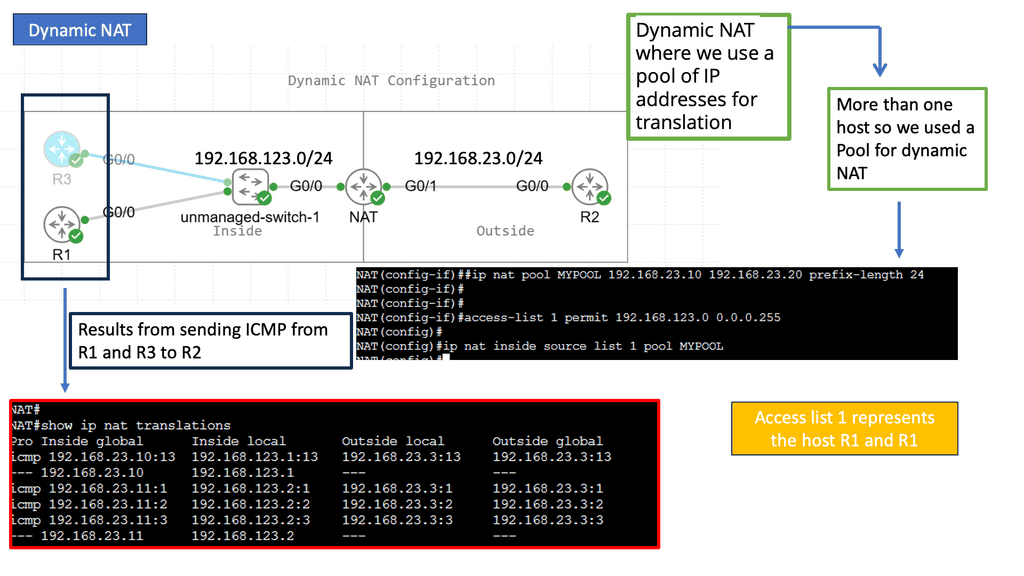
PBR At the WAN Edge
Understanding Policy-Based Routing
Policy-based Routing (PBR) allows network administrators to control the path of network traffic based on specific policies or criteria. Unlike traditional routing protocols, PBR offers a more granular and flexible approach to directing network traffic, enabling fine-grained control over routing decisions.
PBR offers many features and functionalities that empower network administrators to optimize network traffic flow. Some key aspects include:
1. Traffic Classification: PBR allows the classification of network traffic based on various attributes such as source IP, destination IP, protocol, port numbers, or even specific packet attributes. This flexibility enables administrators to create customized policies tailored to their network requirements.
2. Routing Decision Control: With PBR, administrators can define specific routing decisions for classified traffic. Traffic matching certain criteria can be directed towards a specific next-hop or exit interface, bypassing the regular routing table.
3. Load Balancing and Traffic Engineering: PBR can distribute traffic across multiple paths, leveraging load balancing techniques. By intelligently distributing traffic, administrators can optimize resource utilization and enhance network performance.

Performance at the WAN Edge
Understanding TCP MSS
TCP MSS refers to the maximum amount of data encapsulated in a single TCP segment. It determines the payload size within each TCP packet, excluding the TCP/IP headers. By limiting the MSS, TCP ensures that data is transmitted in manageable chunks, preventing fragmentation and improving overall network performance.
Several factors influence the determination of TCP MSS. One crucial aspect is the underlying network’s Maximum Transmission Unit (MTU). The MTU represents the largest packet size transmitted over a network without fragmentation. TCP MSS is typically set to match the MTU to avoid packet fragmentation and subsequent retransmissions.
By appropriately configuring TCP MSS, network administrators can optimize network performance. Matching the TCP MSS to the MTU size reduces the chances of packet fragmentation, which can lead to delays and retransmissions. Moreover, a properly sized TCP MSS can prevent unnecessary overhead and improve bandwidth utilization.
Adjusting the TCP MSS to suit specific network requirements is possible. Network administrators can configure the TCP MSS value on routers, firewalls, and end devices. This flexibility allows for fine-tuning network performance based on the specific characteristics and constraints of the network infrastructure.
WAN – The desired benefits
Businesses often want to replace or augment premium bandwidth services and switch from active/standby to active/active WAN transport models. This will reduce their costs. The challenge, however, is that augmentation can increase operational complexity. Creating a consistent operational model and simplifying IT requires businesses to avoid complexity.
The importance of maintaining remote site uptime for business continuity goes beyond simply preventing blackouts. Latency, jitter, and loss can affect critical applications and render them inoperable. As a result, the applications are entirely unavailable. The term “brownout” refers to these situations. Businesses today are focused on providing a consistent, high-quality application experience.
Ensuring connectivity
To ensure connectivity and make changes, there is a shift towards retaking control. It extends beyond routing or quality of service to include application experience and availability. The Internet edge is still not familiar to many businesses regarding remote sites. Software as a Service (SaaS) and productivity applications can be rolled out more effectively with this support.
Better access to Infrastructure as a Service (IaaS) is also necessary. Offloading guest traffic to branches with direct Internet connectivity is also possible. However, many businesses are interested in doing so. This is because offloading this traffic locally is more efficient than routing it through a centralized data center to consume WAN bandwidth. WAN bandwidth is wasted and is not efficient.
The shift to application-centric architecture
Business requirements are changing rapidly, and today’s networks cannot cope. It is traditionally more expensive and has a fixed capacity for hardware-centric networks. In addition, the box-by-box configuration approach, siloed management tools, and lack of automated provisioning make them more challenging to support.
They are inflexible, static, expensive, and difficult to maintain due to conflicting policies between domains and different configurations between services. As a result, security vulnerabilities and misconfigurations are more likely to occur. An application- or service-centric architecture focusing on simplicity and user experience should replace a connectivity-centric architecture.
Understanding Virtualization
Virtualization is a technology that allows the creation of virtual versions of various IT resources, such as servers, networks, and storage devices. These virtual resources operate independently from physical hardware, enabling multiple operating systems and applications to run simultaneously on a single physical machine. Virtualization opens possibilities by breaking the traditional one-to-one relationship between hardware and software. Now, virtualization has moved to the WAN.
WAN Virtualization and SD-WAN
Organizations constantly seek innovative solutions in modern networking to enhance their network infrastructure and optimize connectivity. One such solution that has gained significant attention is WAN virtualization. In this blog post, we will delve into the concept of WAN virtualization, its benefits, and how it revolutionizes how businesses connect and communicate.
WAN virtualization, also known as Software-Defined WAN (SD-WAN), is a technology that enables organizations to abstract their wide area network (WAN) connections from the underlying physical infrastructure. It leverages software-defined networking (SDN) principles to decouple network control and data forwarding, providing a more flexible, scalable, and efficient network solution.
VPN and SDN Components
WAN virtualization is an essential technology in the modern business world. It creates virtualized versions of wide area networks (WANs) – networks spanning a wide geographic area. The virtualized WANs can then manage and secure a company’s data, applications, and services.
Regarding implementation, WAN virtualization requires using a virtual private network (VPN), a secure private network accessible only by authorized personnel. This ensures that only those with proper credentials can access the data. WAN virtualization also requires software-defined networking (SDN) to manage the network and its components.
Related: Before you proceed, you may find the following posts helpful:
WAN Virtualization
Knowledge Check: Application-Aware Routing (AAR)
Understanding Application-Aware Routing (AAR)
Application-aware routing is a sophisticated networking technique that goes beyond traditional packet-based routing. It considers the unique requirements of different applications, such as video streaming, cloud-based services, or real-time communication, and optimizes the network path accordingly. It ensures smooth and efficient data transmission by prioritizing and steering traffic based on application characteristics.
Benefits of Application-Aware Routing
1- Enhanced Performance: Application-aware routing significantly improves overall performance by dynamically allocating network resources to applications with high bandwidth or low latency requirements. This translates into faster downloads, seamless video streaming, and reduced response times for critical applications.
2- Increased Reliability: Traditional routing methods treat all traffic equally, often resulting in congestion and potential bottlenecks. Application Aware Routing intelligently distributes network traffic, avoiding congested paths and ensuring a reliable and consistent user experience. In network failure or congestion, it can dynamically reroute traffic to alternative paths, minimizing downtime and disruptions.
Implementation Strategies
1- Deep Packet Inspection: A key component of Application-Aware Routing is deep packet inspection (DPI), which analyzes the content of network packets to identify specific applications. DPI enables routers and switches to make informed decisions about handling each packet based on its application, ensuring optimal routing and resource allocation.
2- Quality of Service (QoS) Configuration: Implementing QoS parameters alongside Application Aware Routing allows network administrators to allocate bandwidth, prioritize specific applications over others, and enforce policies to ensure the best possible user experience. QoS configurations can be customized based on organizational needs and application requirements.
Future Possibilities
As the digital landscape continues to evolve, the potential for Application-Aware Routing is boundless. With emerging technologies like the Internet of Things (IoT) and 5G networks, the ability to intelligently route traffic based on specific application needs will become even more critical. Application-aware routing has the potential to optimize resource utilization, enhance security, and support the seamless integration of diverse applications and services.
WAN Challenges
Deploying and managing the Wide Area Network (WAN) has become more challenging. Engineers face several design challenges, such as traffic flow decentralizing, inefficient WAN link utilization, routing protocol convergence, and application performance issues with active-active WAN edge designs. Active-active WAN designs that spray and pray over multiple active links present technical and business challenges.
To do this efficiently, you have to understand application flows. There may also be performance problems. When packets reach the other end, there may be out-of-order packets as each link propagates at different speeds. The remote end has to be reassembled and put back together, causing jitter and delay. Both high jitter and delay are bad for network performance. To recap on WAN virtualization, including the drivers for SD-WAN, you may follow this SD WAN tutorial.
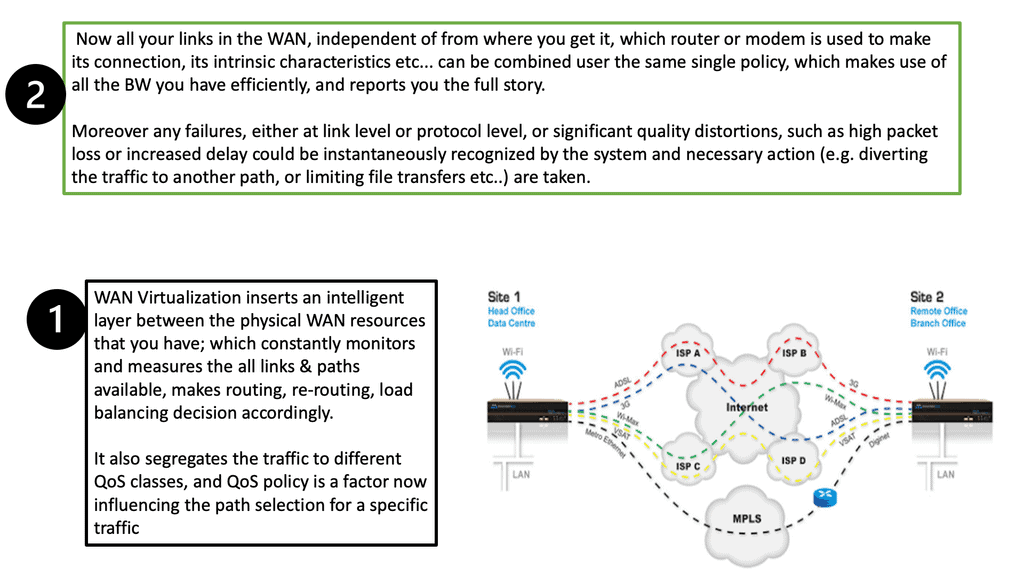
Knowledge Check: Control and Data Plane
Understanding the Control Plane
The control plane can be likened to a network’s brain. It is responsible for making high-level decisions and managing network-wide operations. From routing protocols to network management systems, the control plane ensures data is directed along the most optimal paths. By analyzing network topology, the control plane determines the best routes to reach a destination and establishes the necessary rules for data transmission.
Unveiling the Data Plane
In contrast to the control plane, the data plane focuses on the actual movement of data packets within the network. It can be thought of as the hands and feet executing the control plane’s instructions. The data plane handles packet forwarding, traffic classification, and Quality of Service (QoS) enforcement tasks. It ensures that data packets are correctly encapsulated, forwarded to their intended destinations, and delivered with the necessary priority and reliability.
Use Cases and Deployment Scenarios
Distributed Enterprises:
For organizations with multiple branch locations, WAN virtualization offers a cost-effective solution for connecting remote sites to the central network. It allows for secure and efficient data transfer between branches, enabling seamless collaboration and resource sharing.
Cloud Connectivity:
WAN virtualization is ideal for enterprises adopting cloud-based services. It provides a secure and optimized connection to public and private cloud environments, ensuring reliable access to critical applications and data hosted in the cloud.
Disaster Recovery and Business Continuity:
WAN virtualization plays a vital role in disaster recovery strategies. Organizations can ensure business continuity during a natural disaster or system failure by replicating data and applications across geographically dispersed sites.
Challenges and Considerations:
Implementing WAN virtualization requires careful planning and consideration. Factors such as network security, bandwidth requirements, and compatibility with existing infrastructure need to be evaluated. It is essential to choose a solution that aligns with the specific needs and goals of the organization.
SD-WAN vs. DMVPN
Two popular WAN solutions are DMVPN and SD-WAN.
DMVPN (Dynamic Multipoint Virtual Private Network) and SD-WAN (Software-Defined Wide Area Network) are popular solutions to improve connectivity between distributed branch offices. DMVPN is a Cisco-specific solution, and SD-WAN is a software-based solution that can be used with any router. Both solutions provide several advantages, but there are some differences between them.
DMVPN is a secure, cost-effective, and scalable network solution that combines underlying technologies and DMVVPN phases (for example, the traditional DMVPN phase 1 ) to connect multiple sites. It allows the customer to use existing infrastructure and provides easy deployment and management. This solution is an excellent choice for businesses with many branch offices because it allows for secure communication and the ability to deploy new sites quickly.
SD-WAN is a software-based solution that is gaining popularity in the enterprise market. It provides improved application performance, security, and network reliability. SD-WAN is an excellent choice for businesses that require high-performance applications across multiple sites. It provides an easy-to-use centralized management console that allows companies to deploy new sites and manage the network quickly.
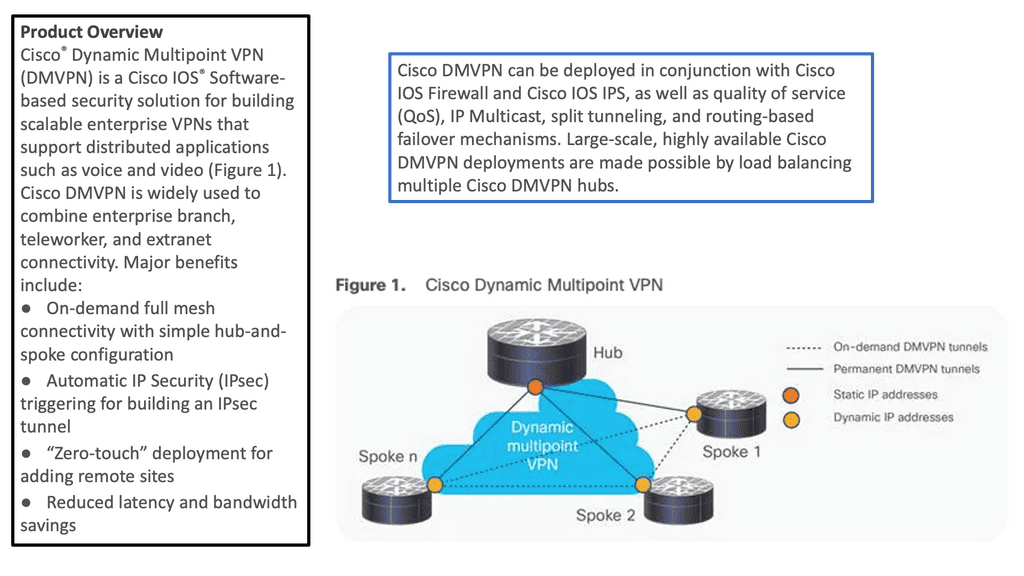
Guide: DMVPN operating over the WAN
The following shows DMVPN operating over the WAN. The SP node represents the WAN network. Then we have R11 as the hub and R2, R3 as the spokes. Several protocols make the DMVPM network over the WAN possible. We have GRE; in this case, the tunnel destination is specified as a point-to-point GRE tunnel instead of a mGRE tunnel.
Then we have NHRP, which is used to help create a mapping as this is a nonbroadcast network; we can not use ARP. So, we need to manually set this up on the spokes with the command: ip nhrp NHS 192.168.100.11
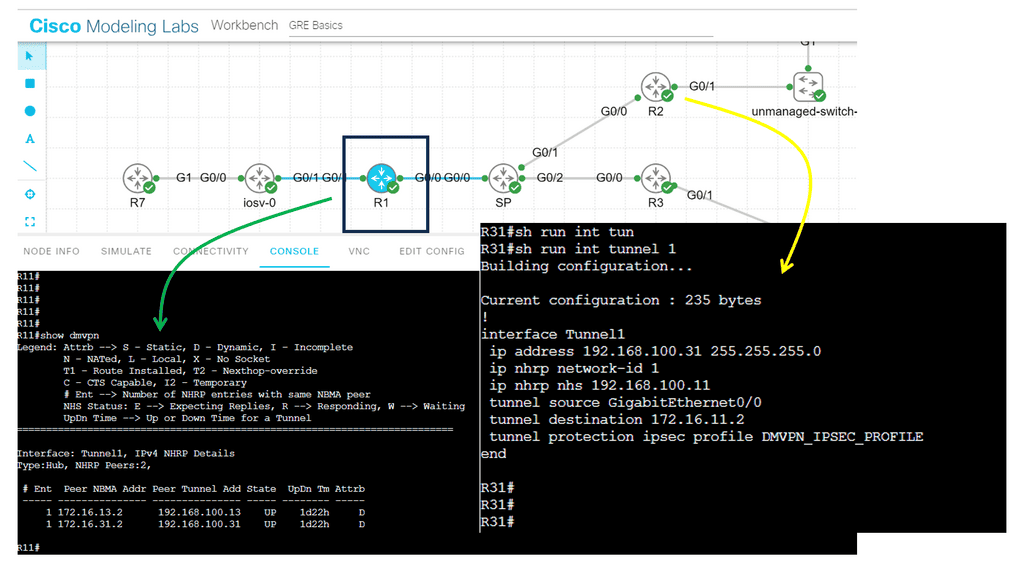
Shift from network-centric to business intent.
The core of WAN virtualization involves shifting focus from a network-centric model to a business intent-based WAN network. So, instead of designing the WAN for the network, we can create the WAN for the application. This way, the WAN architecture can simplify application deployment and management.
First, however, the mindset must shift from a network topology focus to an application services topology. A new application style consumes vast bandwidth and is very susceptible to variations in bandwidth quality. Things such as jitter, loss, and delay impact most applications, which makes it essential to improve the WAN environment for these applications.
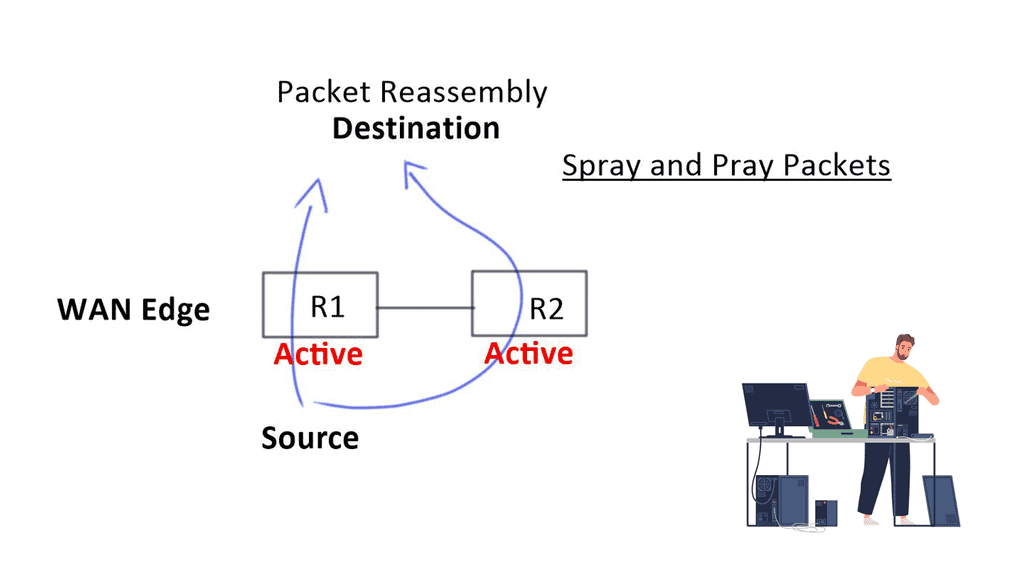
The spray-and-pray method over two links increases bandwidth but decreases “goodput.” It also affects firewalls, as they will see asymmetric routes. When you want an active-active model, you need application session awareness and a design that eliminates asymmetric routing. It would help if you could slice the WAN properly so application flows can work efficiently over either link.
What is WAN Virtualization: Decentralizing Traffic
Decentralizing traffic from the data center to the branch requires more bandwidth to the network’s edges. As a result, we see many high-bandwidth applications running on remote sites. This is what businesses are now trying to accomplish. Traditional branch sites usually rely on hub sites for most services and do not host bandwidth-intensive applications. Today, remote locations require extra bandwidth, which is not cheaper yearly.
Inefficient WAN utilization
Redundant WAN links usually require a dynamic routing protocol for traffic engineering and failover. Routing protocols require complex tuning to load balance traffic between border devices. Border Gateway Protocol (BGP) is the primary protocol for connecting sites to external networks.
It relies on path attributes to choose the best path based on availability and distance. Although these attributes allow granular policy control, they do not cover aspects relating to path performance, such as Round Trip Time (RTT), delay, and jitter.
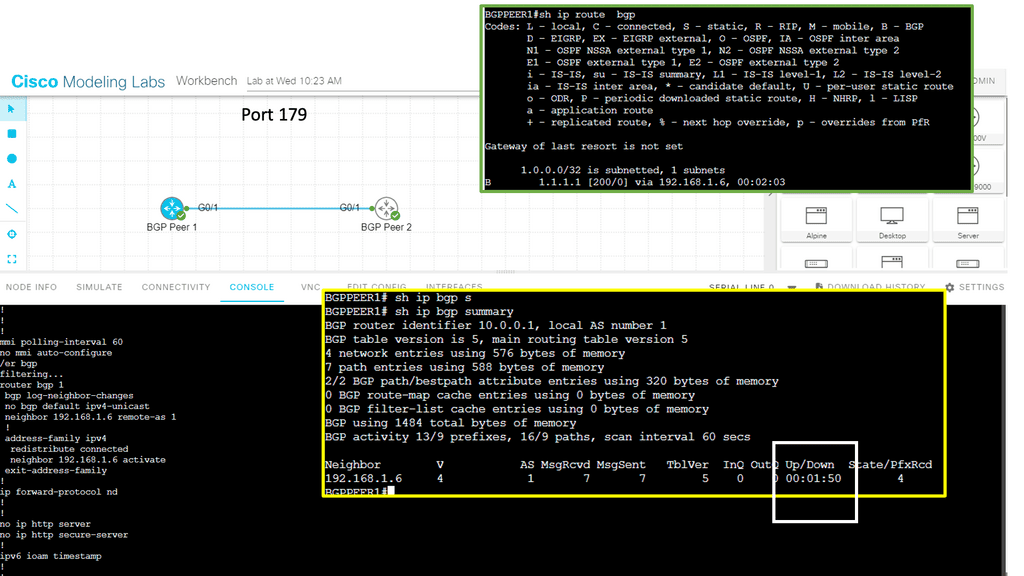

Routing protocol convergence
WAN designs can also be active standby, which requires routing protocol convergence in the event of primary link failure. However, routing convergence is slow, and to speed up, additional features, such as Bidirectional Forwarding Detection (BFD), are implemented that may stress the network’s control plane. Although mechanisms exist to speed up convergence and failure detection, there are still several convergence steps, such as:
Rouitng Convergence | Convergence |
Detect | |
Describe | |
Switch | |
Find |
Branch office security
With traditional network solutions, branches connect back to the data center, which typically provides Internet access. However, the application world has evolved, and branches directly consume applications such as Office 365 in the cloud. This drives a need for branches to access these services over the Internet without going to the data center for Internet access or security scrubbing.
Extending the security diameter into the branches should be possible without requiring onsite firewalls / IPS and other security paradigm changes. A solution must exist that allows you to extend your security domain to the branch sites without costly security appliances at each branch—essentially, building a dynamic security fabric.
WAN Virtualization
The solution to all these problems is SD-WAN ( software-defined WAN ). SD-WAN is a transport-independent overlay software-based networking deployment. It uses software and cloud-based technologies to simplify the delivery of WAN services to branch offices. Similar to Software Defined Networking (SDN), SD-WAN works by abstraction. It abstracts network hardware into a control plane with multiple data planes to make up one large WAN fabric.
SD-WAN in a nutshell
When we consider the Wide Area Network (WAN) environment at a basic level, we connect data centers to several branch offices to deliver packets between those sites, supporting the transport of application transactions and services. The SD-WAN platform allows you to pull Internet connectivity into those sites, becoming part of one large transport-independent WAN fabric.
SD-WAN monitors the paths and the application performance on each link (Internet, MPLS, LTE ) and chooses the best path based on performance.
There are many forms of Internet connectivity (cable, DSL, broadband, and Ethernet). They are quick to deploy at a fraction of the cost of private MPLS circuits. SD-WAN provides the benefit of using all these links and monitoring which applications are best for them.
Application performance is continuously monitored across all eligible paths-direct internet, internet VPN, and private WAN. It creates an active-active network and eliminates the need to use and maintain traditional routing protocols for active-standby setups—no reliance on the active-standby model and associated problems.
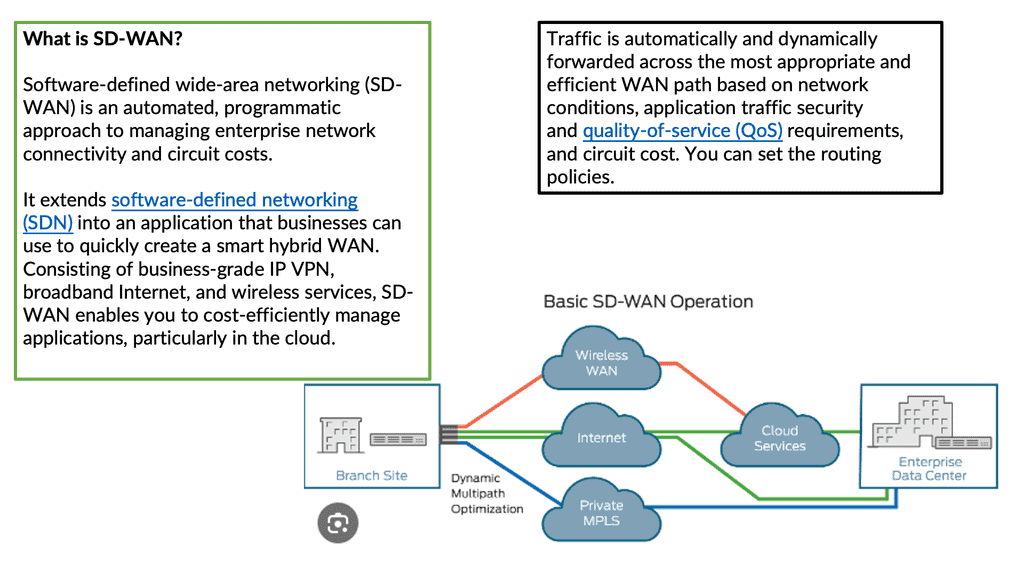
SD-WAN simplifies WAN management
SD-WAN simplifies managing a wide area network by providing a centralized platform for managing and monitoring traffic across the network. This helps reduce the complexity of managing multiple networks, eliminating the need for manual configuration of each site. Instead, all of the sites are configured from a single management console.
SD-WAN also provides advanced security features such as encryption and firewalling, which can be configured to ensure that only authorized traffic is allowed access to the network. Additionally, SD-WAN can optimize network performance by automatically routing traffic over the most efficient paths.
SD-WAN Packet Steering
SD-WAN packet steering is a technology that efficiently routes packets across a wide area network (WAN). It is based on the concept of steering packets so that they can be delivered more quickly and reliably than traditional routing protocols. Packet steering is crucial to SD-WAN technology, allowing organizations to maximize their WAN connections.
SD-WAN packet steering works by analyzing packets sent across the WAN and looking for patterns or trends. Based on these patterns, the SD-WAN can dynamically route the packets to deliver them more quickly and reliably. This can be done in various ways, such as considering latency and packet loss or ensuring the packets are routed over the most reliable connections.
Spraying packets down both links can result in 20% drops or packet reordering. SD-WAN makes packets better utilized, no reorder, and better “goodput.” SD-WAN increases your buying power and results in buying lower bandwidth links and running them more efficiently. Over-provision is unnecessary as you are using the existing WAN bandwidth better.
Example WAN Security Technology: Suricata
A Final Note: WAN virtualization
Server virtualization and automation in the data center are prevalent, but WANs are stalling in this space. It is the last bastion of hardware models that has complexity. Like hypervisors have transformed data centers, SD-WAN aims to change how WAN networks are built and managed. When server virtualization and hypervisor came along, we did not have to worry about the underlying hardware. Instead, a virtual machine (VM) can be provided and run as an application. Today’s WAN environment requires you to manage details of carrier infrastructure, routing protocols, and encryption.
- SD-WAN pulls all WAN resources together and slices up the WAN to match the applications on them.
The Role of WAN Virtualization in Digital Transformation:
In today’s digital era, where cloud-based applications and remote workforces are becoming the norm, WAN virtualization is critical in enabling digital transformation. It empowers organizations to embrace new technologies, such as cloud computing and unified communications, by providing secure and reliable connectivity to distributed resources.
Summary: WAN Virtualization
In our ever-connected world, seamless network connectivity is necessary for businesses of all sizes. However, traditional Wide Area Networks (WANs) often fall short of meeting the demands of modern data transmission and application performance. This is where the concept of WAN virtualization comes into play, promising to revolutionize network connectivity like never before.
Understanding WAN Virtualization
WAN virtualization, also known as Software-Defined WAN (SD-WAN), is a technology that abstracts the physical infrastructure of traditional WANs and allows for centralized control, management, and optimization of network resources. By decoupling the control plane from the underlying hardware, WAN virtualization enables organizations to dynamically allocate bandwidth, prioritize critical applications, and ensure optimal performance across geographically dispersed locations.
The Benefits of WAN Virtualization
Enhanced Flexibility and Scalability: With WAN virtualization, organizations can effortlessly scale their network infrastructure to accommodate growing business needs. The virtualized nature of the WAN allows for easy addition or removal of network resources, enabling businesses to adapt to changing requirements without costly hardware upgrades.
Improved Application Performance: WAN virtualization empowers businesses to optimize application performance by intelligently routing network traffic based on application type, quality of service requirements, and network conditions. By dynamically selecting the most efficient path for data transmission, WAN virtualization minimizes latency, improves response times, and enhances overall user experience.
Cost Savings and Efficiency: By leveraging WAN virtualization, organizations can reduce their reliance on expensive Multiprotocol Label Switching (MPLS) connections and embrace more cost-effective broadband links. The ability to intelligently distribute traffic across diverse network paths enhances network redundancy and maximizes bandwidth utilization, providing significant cost savings and improved efficiency.
Implementation Considerations
Network Security: When adopting WAN virtualization, it is crucial to implement robust security measures to protect sensitive data and ensure network integrity. Encryption protocols, threat detection systems, and secure access controls should be implemented to safeguard against potential security breaches.
Quality of Service (QoS): Organizations should prioritize critical applications and allocate appropriate bandwidth resources through Quality of Service (QoS) policies to ensure optimal application performance. By adequately configuring QoS settings, businesses can guarantee mission-critical applications receive the necessary network resources, minimizing latency and providing a seamless user experience.
Real-World Use Cases
Global Enterprise Networks
Large multinational corporations with a widespread presence can significantly benefit from WAN virtualization. These organizations can achieve consistent performance across geographically dispersed locations by centralizing network management and leveraging intelligent traffic routing, improving collaboration and productivity.
Branch Office Connectivity
WAN virtualization simplifies connectivity and network management for businesses with multiple branch offices. It enables organizations to establish secure and efficient connections between headquarters and remote locations, ensuring seamless access to critical resources and applications.
In conclusion, WAN virtualization represents a paradigm shift in network connectivity, offering enhanced flexibility, improved application performance, and cost savings for businesses. By embracing this transformative technology, organizations can unlock the true potential of their networks, enabling them to thrive in the digital age.


